#some of this is interpretation of the comics and other parts are mere speculation
Note
i actually think its really cute how Black Spy seems kinda open with his sexuality meanwhile White Boy,the "put-together" one, has this incredible closeted vibe. something magical is about to happen
I've always seen it as both initially being closeted, both trying to appear as straight as possible.
I think Black Spy puts a lot of effort into appearing to be attracted to women, especially if he thinks someone is making a move on him. It's so unnatural for him that he comes off as too exaggerated, as if he's trying so hard it becomes obvious he's playing an act. Whenever he attempts a romantic interaction with a woman, it *always* goes wrong for him. Even after a failed attempt at a relationship with a woman, he builds a robot to appear to have a girlfriend of some sort, and it still doesn't work out. Perhaps, eventually, he becomes more comfortable in expressing his true self... At least, as much as he can in an unaccepting environment. Perhaps in subtle ways, such as flagging in bars, i.e., the pool table title illustration.
White Spy, on the other hand, might be bisexual, and therefore, it's not as difficult for him to pretend to be attracted to women. There's actually a sense of genuineness in his edeavors. However, he might not have his heart set on any particular woman but rather for his enemy. Take, for instance, when he agrees on one of the causes for his dreams of Black Spy being his own repressed sexuality. (This could have also been a case of projection, as Black Spy was the first to even mention it whilst in disguise.) The tension he feels may build up over time, eventually coming to his undoing. He's so put-together on the surface, but once confronted with his attraction, he might become a total mess. Perhaps the opposite may be true for Black Spy.
It may start out as a Distaster Gay vs Distinguished Bisexual situation, slowly growing into a Distinguished Gay vs Disaster Bisexual one. Only relatively speaking. They're both absolute messes of men.
The two may be stuck between wanting to be themselves and express their true feelings towards each other and not wanting to be outed to their embassies and society at large.
It becomes more difficult with the added layer of them not only falling for a man in a homophobic society but for a man working for the enemy. Even if their environment becomes more accepting over time, they'd still be at risk of being charged for treason over their relationship.
#spy vs spy#black spy#white spy#spy x spy#headcanons#ace's ramblings#some of this is interpretation of the comics and other parts are mere speculation#but in my heart it is all true#ace's answers#thank you so much for sending this in!!#i actually ended up combining the post i was already writing up with my answer to this
23 notes
·
View notes
Text
retrospective & predictions
Since we're on a hiatus week (between 320 and 321) I feel like waxing poetic about the depth and growth of bkdk for a bit. Especially because it seems like we’re right on the edge of their biggest development yet, I’m getting the urge to lay all my perspectives and insights I’ve picked up from others out on the table. This is ultimately only my subjective interpretation of subtextual material in canon, though. If you’ve never quite understood what people see in their dynamic and you’re actually open to hearing me out, maybe from this you can at least see where we’re coming from. And if you don’t like my takes after all, well, we’ll see who’s right in the coming chapters, won’t we? What I have to say can be taken platonically or romantically; I appreciate both.
putting it under the cut, since it’ll be long:
At the risk of projecting, I want to start by examining a couple things based partly on personal experience.
From many different directions, I often hear people expressing that Deku’s persistent attachment and admiration for Bakugou is baffling at best. Despite the bullying, despite Bakugou’s loud, rude, and uncompromising personality, he still puts effort into their relationship and frequently describes him as amazing. It seems like Deku himself is aware of this as he’s said things along the lines of how he’s difficult, BUT... etc. Although I don’t think it’s exactly that Deku finds Bakugou’s personality hard to be around, but that he’s deliberately expressing patience for Bakugou’s emotional turmoil.
I have to say I know what this sort of patience is like, as I went through it with someone I love. I only chose to put up with their behavior because I decided the possibility of what our relationship could be was worth it. I wasn’t blind or submissive to how they treated me, and I wasn’t coerced. I simply expressed myself and established my boundaries while still allowing them the opportunity to join me in my world once they got over their own hangups. And guess what? It worked out in the end. That doesn’t mean there aren’t circumstances where it’s better to cut ties, but I want to stress that true reconciliation is possible sometimes. I used to worry that other people around me thought I was delusional for seeking it, but what really helped was my therapist reminding me that I’m smart and strong. So I think Deku deserves to feel the same. In a way this is his whole mission in life, his approach to being a hero as well as his personal relationships.
Let me also be clear though that I don’t mean Deku is only tolerating Bakugou’s personality, his mannerisms, the parts of him that will likely never change. I’m drawing a line between those things and his emotional state (they so rarely align anyway, but I’ll get to that later). In fact, I think Bakugou’s general attitude is part of what Deku admires. This is gonna be hard to explain without inserting personal experience too, sorry. As a writer myself I’ve noticed I’m drawn to writing characters that are brazen and bold and don't mind telling people off. Really it’s because I operate in the world in the polar opposite way. I try not to draw attention to myself, I’m quiet, and I’m a people-pleaser. People who project confidence, especially in an impolite sort of way, fascinate me. It’s good to take cultural context into account, too: I've heard people who’d know better than me that part of the reason Bakugou is the most popular character in the Japanese fandom is likely because he contradicts a lot of their social norms. His disregard is refreshing and cathartic. I can speculate that Deku has a similar point of view based on what he thinks but does not admit about Bakugou being his image of victory and how this sometimes makes him mimic Bakugou’s speech and mannerisms:
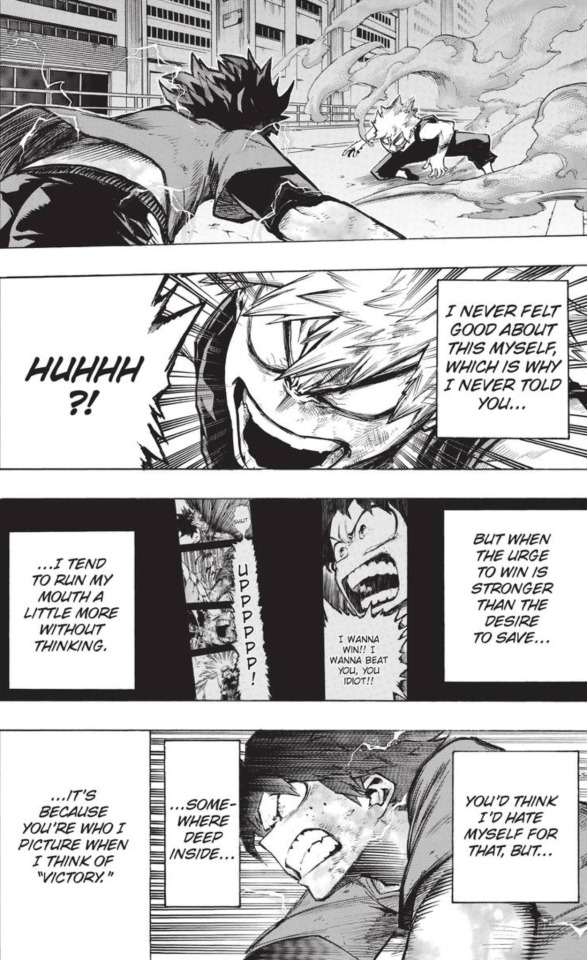
There’s also the bit in this fight where Deku realizes he's the only one able to receive Bakugou’s emotions. This is because he’s the most intimately familiar with him and his situation, but I think there’s another layer. Deku, as we know, has a self-sacrificing tendency, and in the current chapters we’re seeing the worst side of that. But let’s also not forget that to an extent, it can be a positive trait: resilience. When it comes to Bakugou, he has an almost comical ability to dodge the potential fallout of his outbursts. The example we all jump to (and fight about..) is how in ch1, apart from the initial shock of Bakugou suggesting he jump off the roof, the most he reacts is to criticize him for saying such a ridiculous thing. However, I think their interaction post- sludge villain is a lot more interesting:
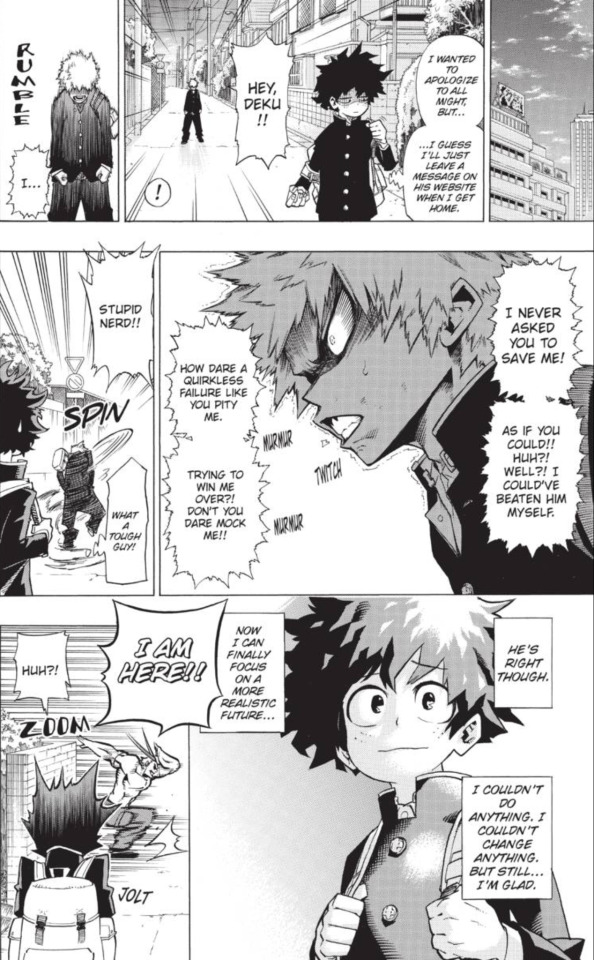
Note two things: 1, in his head, Deku is practically making fun of how Bakugou’s acting as he stomps away without waiting for a reply. It doesn’t faze him. 2, Deku thinks, optimistically, that he can now focus on a different career choice. This is astonishing really. Up to this point, none of Bakugou’s attempts to put him down have worked; he just kept pursuing his dream. The only reason Deku concedes in this moment it because for the first time, he has been shown that he really couldn't do anything in a fight against a villain. All Might told him he couldn't be a hero (although he’s literally about to take that back in the next few pages lol) and the other heroes at the scene gave him a lecture about it too. It was those experiences, and not Bakugou’s words, that truly affected him. And when All Might tells Deku he can be a hero after all, it’s not thinking of Bakugou’s bullying that makes him sob and fall to his knees, it’s the memory of his own mom never telling him those words he so desperately needed to hear. Having spent most of their lives together, Deku must have been aware all this time that Baukgou was influenced by larger societal forces rather than a core judgement, so he didn’t take it personally. He separated the person from the action, and because he’s resilient and patient, he is thus equipped to handle Bakugou’s emotions. It’s a testament to his maturity and emotional intelligence, really.
But I can almost hear some of you saying, “that doesn’t mean Deku should have to be the bigger person here!” Correct! Just because Deku is perfectly alright bearing all of that, doesn’t mean atonement-era Bakugou sees it this way. We can track his awareness of Deku’s care and selflessness as follows-
The bridge scene, when they’re little kids: Bakugou conflates Deku’s heroism with pity, and subsequently thinks Deku is looking down on him because Bakugou’s own insecurity makes him defensive.
The Sludge Villain, and also Deku vs. Kacchan Part 1: Bakugou witnesses first-hand how easily Deku jumps to risk his own life, but still thinks he’s being looked down on.
The Sports Festival: Bakugou fights Uraraka and recognizes her endurance strategy and refusal to give up as very Deku-like. He’s half right. He thinks Deku advised her in the fight, when in reality she just mimicked Deku because she admired him. I want to draw attention to his very sober comment about her not being frail. It’s a great endearment of Uraraka’s character and Bakugou’s respect for her when others didn’t take “fighting a girl” seriously, but it also reflects on his opinion of Deku. Deku isn’t weak either. He never was.
Deku vs. Kacchan Part 2: Deku finally corrects him about the whole looking-down-on-him thing, and Bakugou is informed that Deku’s selflessness is in fact the reason All Might chose him. Since Bakugou had been in search of what he himself was “doing wrong” for All Might to favor Deku over him, he now has to reconcile the fact that selflessness is a heroic trait, and moreover something he lacks. This is also possibly the first time Bakugou is able to see his past actions toward Deku as bullying since he previously thought it was more mutual. Additionally, Bakugou can now link Deku’s selfless behavior to what he perceived as pity/contempt, and realize that Deku has been giving him A LOT of grace. Maybe too much. Maybe more than Bakugou deserves, and definitely more than Deku should have to. Holy heck- now Bakugou has to figure out how to live up to all the faith that’s been placed in him.
Subtextually, we can see Bakugou’s feelings about atonement reflected in the Todoroki family:
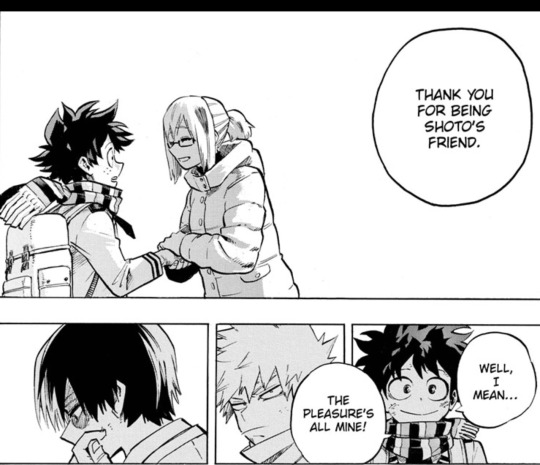
1, Shouto is another example of Deku growing a friendship using his selflessness (since their fight in the sports festival) and their relationship is being acknowledged here where it hasn’t been in Bakugou’s situation. Perhaps Bakugou is wishing it could be so simple for him, to be able to thank him for being his friend like that. Deku saying the pleasure is all his also probably calls to mind how a mere apology from Bakugou would probably be dismissed because that’s just the kind of accommodating person Deku is. Bakugou has to operate more quietly in order to actually make up for their past. I personally don’t interpret this scene as Bakugou being jealous of Deku and Shouto’s friendship, exactly, just the lack of emotional baggage. Side note, Deku and Fuyumi are kinda similar in their desire to repair relationships. I like that she’s the one to give him some credit.
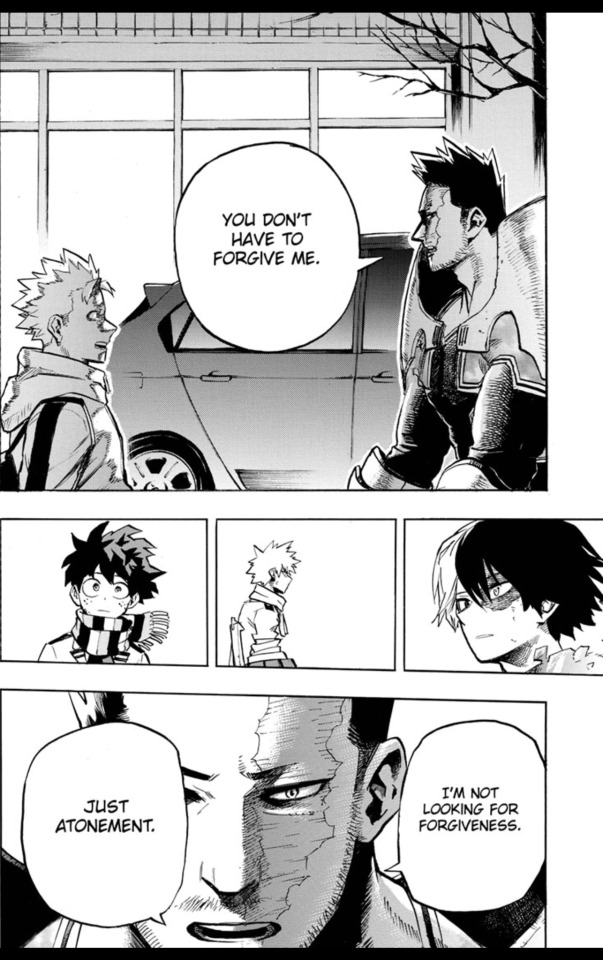
2, With the common terminology, this can be interpreted as Bakugou receiving a model for atonement, one that is about action, and nothing to do with receiving favor or forgiveness. It’s a sense of duty.
Many of the above sentiments are repeated in the flashback conversation between All Might and Bakugou right before Bakugou’s sacrifice.
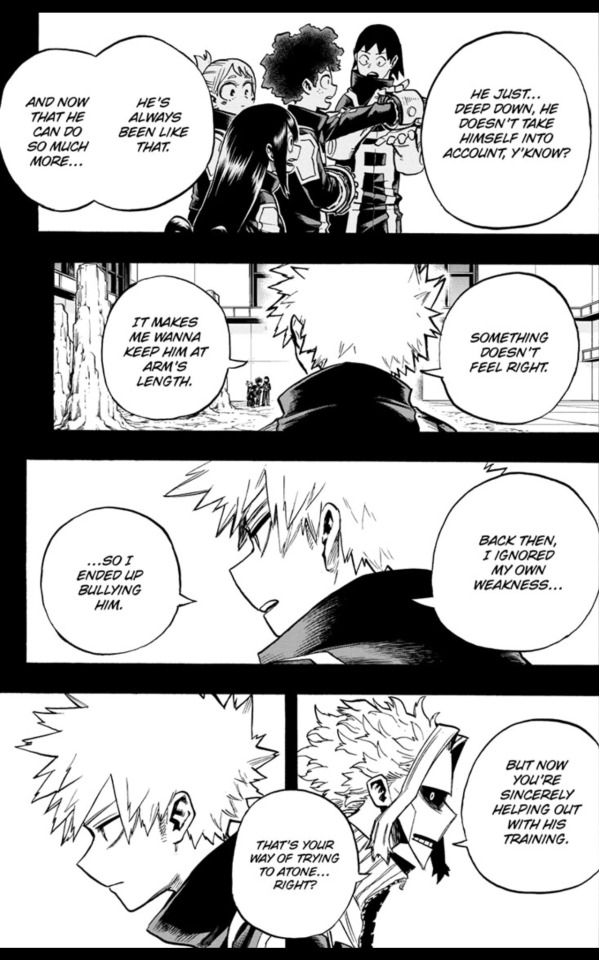

Bakugou acknowledges his bullying and that it happened because of his own insecurities, but aside from that, it’s interesting he neither confirms nor denies All Might’s suggestion that he’s trying to atone, or that Deku doesn’t see it that way. All Might is a bit of an unreliable mentor sometimes, but I don’t think he’s misreading here. Rather, Bakugou is displaying his tendency to hold back when talking about things that would make him really emotional. Besides, admitting to what he’s doing kind of defeats the purpose. He isn’t seeking acknowledgement. All Might has gotten to the crux of the issue here when pointing out that Deku doesn’t recognize the atonement, likely because Deku doesn't think Bakugou even needs to atone. Am I reading into it too much to say Bakugou looks wistful at this? It’s kinda frustrating sometimes trying to interpret Bakugou’s actions because he’s so paradoxical. Loud and in your face, but also extremely reserved. Sometimes I feel like I’m grasping at thin air, but hey, being hard to figure out is part of his intrigue as a character. The simplest way to look at him is to assume that unless he’s really showing vulnerability, he’s probably deflecting and hiding something.
Speaking of Bakugou’s tendency to to hold back emotional stuff, there’s his apparent lack of issue with Deku calling him Kacchan. Maybe to begin with, in his warped perception of things where he thought they hated each other, Bakugou saw it as Deku’s way of getting back at him for calling him “useless,” and didn't dare give any indication that it actually bothered him. However... consider how betrayed Bakugou has appeared when he was noticeably thinking Deku was looking down on him- the bridge scene, and the beginning of their first year at UA when he thought Deku was hiding a quirk all along. He looks shocked and hurt. That kind of emotion couldn’t be invoked by someone Bakugou didn’t actually care about his relationship with. “Kacchan” comes from a long time ago, before their relationship was strained, so it’s connotations are pure. Maybe somewhere deep down, Bakugou has always been hoping that Deku’s continued use of the nickname was not simply a matter of habit or teasing, but a vestige of friendship they’re both clinging to, and Bakugou himself was too afraid to admit to himself that he felt this way about it, so he mostly ignored it. (These are not original thoughts I am having here lol, this is a common interpretation. I’m just laying everything out like I said.)
And now we turn to the current situation. Personally, I’ve been looking frantically back and forth between them wondering who’s going to break down first (Deku vs. Kacchan Part 3, this time it’s just a fight to get the other person to cry? ha.) Both have looked like they’re approaching a breaking point for some time. Also, I’ve addressed this before, but I think it’s significant that Bakugou is no longer wearing his mask with his hero costume, in contrast to Deku recently donning his own. It feels symbolic of Bakugou about to be upfront about how he feels.
The question is, what is it going to take to get Deku to accept help? If you ask me, Deku has dug himself so deeply into the I’m-doing-this-for-everyone-else’s-safety-and-smiles hole, no common sense argument can possibly reach him. By the end of 320, Deku’s mask is off, and we can see how desperate he truly is. But he has not cried, yet. I predict we’re going to see a bit more of his defiance, this time on full display on his face as the remaining class members and his other friends take their turns. But then I think Bakugou has to be the one to break down so Deku can witness his actions having the opposite effect he intended. People have been pointing out that Deku is currently ignoring Bakugou, and oof, that’s gotta be intentional. Regardless of what Bakugou says, it’s going to be wrapped up not only in his understanding of Deku’s self-sacrifice, but also the betrayal Bakugou feels at being ignored/left behind that ironically echoes his previous perception of being looked down on, as well as a need to express how much he cares about Deku before it’s too late. He must show that the two of them are inseparable because they both act to save each other without thinking, and both feel like losing the other would be like dying themselves. All Might may have been right when he told them they could learn from each other after Deku vs. Kacchan Part 2, but he didn’t fully realize that idea by making sure they stuck by each other for support and balance.
I can’t wait to see what it’ll be like when they do finally get to that point, totally in synch and in tune with each other. They’ll be a powerful force no one is quite prepared for. Who knows when that will be, or even which chapter will be their big showdown, but I know the day is coming.
To speculate even further, I think the 2nd user is going to be really important really soon. And no I don’t mean to suggest that the 2nd user is Bakugou. But I do think their resemblance is key. Okay this is gonna be convoluted...

See how 2nd is the only one still standing? I think that’s symbolic of him withholding his quirk. Deku may not even know what it is at this point, let alone have unlocked it. Given that 2nd approves of Deku’s strategy at this point, it seems odd for him to withhold his quirk based on lack of faith. I think if his quirk was something that would help Deku in combat, he would have shown it to him already like the others did. So what if those gauntlets of his are support items that are meant to make up for his lack of a combat-oriented quirk, rather than to augment it? Mind you, I still have no idea what his mysterious power might be, but I’m dead set on it not being explosion-y. Regardless, I think 2nd looking like Bakugou is more about aiding some grand visual parallel, so! You know how 2nd and 3rd were probably intending to do away with Yoichi but 2nd changed his mind as soon as they made eye contact? This is really a long shot, but I wonder if 2nd’s quirk has something to do with that exchange. Maybe it’s something psychological, or some 6th sense about people he meets. So... in that way 2nd’s quirk could play a role in bkdk reaching a deeper understanding? Idk! But it could be significant at least that 2nd left Yoichi’s question about why he reached out to him unanswered.
One more thing- while I was gathering screenshots I found this. I think “you’re the last one I’m telling” might be foreshadowing for Bakugou revealing his hero name to Deku and it being a Big Deal:

As for other lingering threads in the overall plot right now, such as the UA traitor, Stain, whatever Tsuyu is apparently about to do, All Might’s car maybe in the background of the last page of 320... man I have no idea. All I know is there’s literally 320 chapters’ worth of build-up to this confrontation that can’t be interrupted.
See you next week <3
#phew that was a lot#I just wanted to show how things are aligning#I know a lot of this has been said#bnha manga spoilers#bnha 320#bnha 321#mha#bakudeku#bkdk#bakugou katsuki#midoriya izuku#bnha meta#lin speaks
90 notes
·
View notes
Text
Zelda 2 - Mystery of Kasuto
Yet again, with more Zelda 2 lore.
Since winter break started, I went back to working on my Zelda 2 comic again (it’s been years but I’m still going at it haha). I collected a LOT of information from within the game and from other loz games. I’m at the last stages of getting all the information needed for a fully fledged story (My aim with this comic project is to flesh out the world of Hyrule in the era of decline. Make it feel like the newer Zelda games in terms of lore and plot, but also keep its’ classic essence).
HOWEVER! Before I get ahead with outlining a full story, there is one thing that needs to be sorted out. that is, Kasuto Town. Deciding on Kasuto town’s identity will entirely change the aesthetic of the story, how the people will be represented, and even the lore of the Zelda2 pre-story (sleep-cursed Princess Zelda)
I’ve spent a while collecting evidence and clues for my theory. I was not sure if I should go ahead with it and solidify it for the comic, so I want to share it and hear what opinions, additions, or contradictions any of you would have. I’m very interested to hear what you have to say on it! Anyways, without further ado, here is the theory:
The basic idea is that Kasuto People are Sheikah.
(Disclaimer: This is just a theory and entirely speculative. The aim to try to make sense of Kasuto town with the established canon information we know and fit it to the wider loz world.)
1. Location of Kasuto Town

There are two Kasuto towns. A deserted Kasuto, and a hidden Kasuto.
From what we know of the Sheikah history leading to the downfall timeline, is that The Hyrulean Civil War (Pre-OOT) nearly wiped out all of the Sheikah population. Kakariko was their original settlement, but has since been opened to everyone. So, where did all the Sheikah go? Only Impa is around. WELL, perhaps since the events of the civil war, they decided to take residence far away from Hyrule Castle, and only send their most capable every generation to care for the Princess (Which is always the new Impa). Impa always shows up again as a nursemaid for Princess Zelda in the downfall timeline.
Additionally, as protectors of The Royal Family, it works out how their town is situated next to the entrance to the Great Palace, where the final Triforce is kept (To keep an extra eye on who ventures there?).
Not entirely sure why Kasuto was destroyed. Did Ganon know about the Triforce of Courage being around there? Did he attack them with an army of Moas while they fought to keep him away? This might have led them to go into hiding. They are the only ones who know all the secrets of Hyrule. They need to survive in order to preserve it.
2. Magic
There are two spells taught in the Kasuto towns. One of them makes a small temple (shrine?) come out of the ground. The other spell is the strongest spell in the entire game (thunder).

^ This is the building that emerges from deep underground after using the ‘Spell’. (He finds the magic key there. A key that can open pretty much every door ever. Or at least the palace doors).
What IS strange about Kasuto though, is that the palace situated between the towns has an item that acts almost exactly like the Lens of Truth; It’s a cross that allows Link to see ghosts. (In OOT it does the same thing, in addition to looking through false doors and floors. It’s used to track down the Phantom guide in the haunted wasteland). A little suspicious, no? (PS. I’ve been thinking about redesigning the cross item for the comic, and I SWEAR the three parts at the top can easily be made to look like the Sheikah eyelash symbol. Voila)
This could all merely be coincidence, but the location next to the Great Palace AND the three-eye-rock palace containing the cross is convenient to make us assume it’s connected to them in some way, especially with the later established lore of the Sheikah.
3. Technology
Ok. bear with me. This is a big one. This will be the game changer. If we can solidify that these Sheikah are just as technologically advanced as the Sheikah in botw, this will completely change how they could be interpreted in the comic.
For starters, only the Sheikah know the details of the legend of Zelda. And here I quote from the Zelda 2 1988 manual:
“There was a door in the North Castle called “The door that does not open.” Only the descendants of the Impa family who served the King knew how to open the door.”
As we could see, access to the chamber and scrolls that provide information on the palaces and Triforce is only accessible to the Sheikah. A private affair between the royal family and Sheikah ONLY? The King that separated the Triforce is the one that was in-charge of building all 7 palaces. Because the Sheikah work closely with the Royal Family, they must be 100% involved (Also, remember how Kasuto town has the magical key that can open all doors in the palaces?)
OKAY NOW HERE IS THE TECHNOLOGY PART
The elevators. The Elevators.
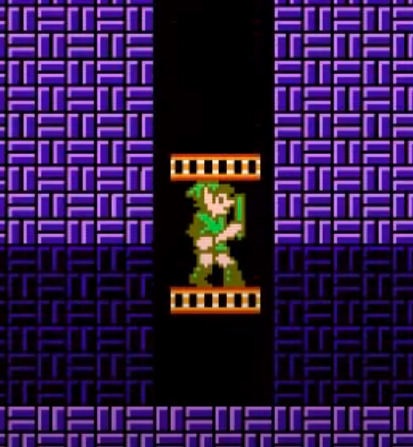
For the longest time I told myself it must be some kind of pully system. But after I started thinking about Kasuto as being Sheikah, and their heavy involvement with the palaces, I’m starting to think that maybe these are actually electrical (or magical. idk what it is) powered elevators. Sort of like in Breath of the Wild.
There is also Rebonack, the Island palace boss with his floating robot horse


Maybe.... Maybe the ironknuckles and doomknockers are also robots? For all we know, they are just heavily armored... things. With no face.
We know construction on the palaces must have begun sometime at the end of the Golden Era. That was the time when the Royal Family possessed the full Triforce for countless generations. It was the most prosperous Hyrule has EVER been (in the downfall timeline at least). The Sheikah might have had the time to advance their technology? It’s not too far fetched.
After such a long time of prosperity, the King found that there was no one worthy of the full Triforce to continue this golden age (He was scared of his wicked son it seems) so he started this whole project to hide away the Triforce of courage.
(It’s interesting in a way how that King saw that the chaos caused by a separated Triforce is much merciful than the consequences of the full Triforce falling into the wrong hands. It mirrors Princess Zelda’s decision when she broke the Triforce of wisdom into 8 pieces so Ganon can’t have it. She really is wise for a small child. As wise as the ancient king.)
Well, what are your thoughts? Would it be plausible that the people at Kasuto are truly the Sheikah? Is it possible that the palaces have technology?
This is pretty crucial for the development of this comic project 👀 It will completely change how the palaces will be portrayed, the enemies, and the entire Kasuto settlements (plus if Impa is affiliated with them). WOULD you be fine with such an interpretation?
SHARE YOUR THROUGHTS!
#zelda2#long post#zelda2 lore#I'm pretty hyped about this haha#I've been kinda in the shadows about this project BUT I decided I might be ready to tackle a comic#the past year I did some multi-page comics#so that was great practice#I think I'm ready to REALLY start delving into this one#a multi-chapter and multi-volume comic. fun#mmmm#I'm flipping this whole game. I'm gonna add so much plot and drama and suspense and HAHAHAHA#sorry I'm just really excited about this#There IS a way make this game work. There is enough material deep inside to allow for a fully fledged story and world
104 notes
·
View notes
Text
ok ok ok so this has been in my brain for a very long time and my loved ones have been hearing me infodump about it CONSTANTLY so here goes my analysis on:
SANCIRC, MENTAL ILLNESS, AND NEURODIVERGENCY [As written by an autistic/adhd person who’s special interest has been sancirc for over 4 years]
ok im going to get the most obvious characters out of the way, which are sammy and attley as being autistic/adhd coded.
attley and sammy both have special interests [sammy with stamps and attley with detective fiddle, a radio show they named their spider after, and also spiders or bugs in general]. sammy has been shown indulging in stamps and trying to infodump about them to posey and is shown buying stamps.
there has also been a doodle of attley kicking their legs back and forth, which i interpret as a stim. [i saw this drawing a while ago and havent gone back in the sancirc tag that far recently] specifically a happy stim
along with a scene in the very first chapter where attley plays a prank on her little brother by dropping dead bugs on him. they dont understand that he is upset until he is crying and after that they just, withdraw. which is a common response from an autistic person who understands that they messed up and instead chooses to remove themselves from the situation.
outside of these ideas we dont have much of a foundation since attley has been having A Time and sammy hasnt been explored as much in the comic yet.
and now for the main part of the essay. posey morris. posey is a very
fun. look into mental illness. it has already been speculated to be mentally ill or neurodiverse by fans, even though these comments have come off as ableist in some senses. a few actions posey has can be seen as a trauma response, along with its dependency on attley stems from years of mental abuse at the hands of tedley, and at the very end of the comic, physical assault and dismemberment.
i see posey as a very mentally ill and paranoid individual with severely clouded judgement and a hard time processing reality. it is in touch with reality and can process some aspect easily but some times it isnt quite there.
an example of this is another scene in the first chapter where it assumes that attley is already suspicious of it not being human when attley has established to it that.
1. they didnt even know that posey could do magic
2. and basically knows nothing about magic
posey immediately took a giant leap of logic and assumed that it had messed up, with proof against that already that it disregarded.
another display of trauma is how it generally acts around tedley, an abusive father figure. its demeanor completely changes at the mere mention of him and it flinches, sweats and is generally meek and nervous around him.
there seems to be a posey for every situation, a different persona that starkly contrasts another. there is one for attley, for other scarecrow, for victims, and there is a silent and defeated posey for occasions where its being yelled at by tedley or stuck in the NO.
i may be looking too far into it but posey seems to use spycrows much more compared to other scarecrow, having some in constant usage and while having a panic attack an over production of spycrows that end up unusable but still somewhat alive. spycrows are essentially what have given posey the upper hand up until that point, until that page they are known as a sign of impending doom and danger. after that page i see them as a coping mechanism, a way for posey to control the situations before putting itself in there.
the spycrows are a very feeble sense of control that posey has, while creating the deformed spycrows posey is in a very stressful and uncontrollable situation. posey is essentially having a panic attack before tedley returns and verbally abuses it and tells it to murder the only person that posey has deemed as safe or close to it.
when it comes to it, posey will always be motivated by or for attley, whether it be finding them, helping them [in whatever posey defines as “help” in the moment]. posey is extremely dependent on attley, which is very unhealthy for their relationship at the current moment.
posey has been in a situation it cannot control and is not familiar with. attley was integrated in poseys life to a point where posey can not let go of attley. attleys disappearance from poseys life has caused a lot of negative responses to come out because up until attley disappeared they were the only support posey knew.
scarecrows on average suffer a lot of trauma from simply dying and being roughhoused, posey is just what we have seen so far and how it reacts to stressful situations.
in conclusion: posey shows a lot of signs of being mentally ill, attley and sammy are autistic coded. and if you have read all the way down here <3 thank you for sticking through my inane ramblings!
#sancirc#sanity circus#sammy talbot#attley grimshaw#posey morris#text post#analysis#windy you are free to correct me on any of this if you get it just know that i have thought about this a Lot
10 notes
·
View notes
Text
The Not-So-Amazing Mary Jane Part 34: AMJ #6.1

Previous Part
Next Part
Master Post
You know I considered ending this series after the initial arc. I may well discontinue it after awhile. But for now at least I am going to press on. Thus begins the second of what I and dead certain will be a shitty arc of AMJ. Pray for me.
Before we dive into the issue I want to quote for you the solicit for this issue:
WELCOME TO NY, MJ! After the CAN’T-MISS events of AMAZING MARY JANE #5, your favorite redhead is back home! First stop: Spider-Man! But has her relationship with Mysterio changed things with the love of her life? Next stop: a press tour! Complete with iconic New York guest-starring gigs, and OH NO WHAT’S THAT?!?
We spent over 10 years of seeing Peter and MJ separated in the 616 universe.
Thanks to Nick Spencer they blessedly got back together.
Across 25 issues we got to see Peter and MJ interact and 99% of the time it was awesome and helped some old and open wounds get a little better.
It wasn’t every issue, but that was good. Don’t want to get indulgent right?
Then this series came along and Peter/MJ interactions got limited again due to the nature of the story.
That was a shame but at least we were going to get a great MJ story right?
Except we didn’t. We got a story that paradoxically simultaneously celebrated MJ whilst also inadvertently character assassinating her and just being a disgusting fucking mess in general.
But here we have MJ back in New York where Spider-Man is. This issue is even promising us an interaction between them.
Sounds good right?
Let’s see if it will deliver.
As always here we get the recap.

And once more it gives us the full title of the movie in spite of the comic yet to have done that.
As for the ‘strength of his vision blah blah blah’, you know the drill by now. That’s all bullshit, Mary Jane would never connect to Beck over that or allow him to walk free because of that.
There is also a passage in the recap claiming that MJ connected to Beck over familiarity with his situation. The idea of this being their last chance to make it big. I’ve already talked about how that’s bullshit, see part 12.
Finally, the recap confirms that MJ has still failed to tell Peter the truth. Nice to know MJ will continue to be hardcore out of character moving forward into this new arc.
As the issue starts we see MJ introduced as a guest on some kind of chat show.

As has been the case throughout the series, the art is (stylistically at least) gorgeous.
Beyond that there is little to about this page. Except of course the fact that Mary Jane has thought captions.
Let me repeat that.
For the first time in six issues the readers are being given an insight into the thoughts of title character!
You know, if this were a brand new run, a re-launch or even say the beginning of an outright new era for a series maybe that’d be okay.
But it isn’t. It’s the same run, the same volume, the same story, merely the next arc. This is like if Nick Spencer hadn’t used thought captions throughout the first five issues of his ASM run but then randomly did for the Trivia Night storyline with Boomerang.
Thought captions are perhaps one of the single most potent weapons in the arsenal of a comic book writer. It allows for immense development of characters and enables writers to combine the strength of prose stories with those of more visual mediums.
Now, it’s not that it’s bad to simply not use them. But be consistent. Thought captions would’ve gone a long way in helping us understand Mary Jane better in the first arc along with elaborating upon her asinine decisions there.
Not to mention for a character so often written off as shallow or just eye candy wouldn’t an insight into her thoughts have helped dispel such accusations? Jed Mackay has been doing that pretty consistently since the first issue of his Black Cat run. There it has done wonders for Felicia and fleshed her out more.
It’s especially bad when we consider we got more of an insight into MJ’s thoughts and feelings in one issue of Nick Spencer’s ASM run than in the entire five prior issues of her solo title.
Anyway, as her interview with Reilly Redding begins there is some quips and verbal jousting going on. Reilly asks if the movie has wrapped but MJ explains that McKnight and the crew are still shooting in L.A. Reilly asks if MJ is sure about that.

This isn’t a positive, more a general observation. I’m not overly familiar with chat shows, let alone American ones, but to my eyes the host seems influenced by Ellen DeGeneres.
Anyway, let me dispense with the pettiest of gripes first. I hate Reilly’s hairstyle. I hate that hairstyle in general. To me it looks really stupid, like you went for a haircut but gave up halfway through. That’s not in anyway shape or form a fair criticism. I totally own that. It is just a tiny point that really bothers me personally.
On the more positive side, Williams continues her frustrating tendency to nail MJ’s personality traits within a problematic context. MJ’s social skills are one of her greatest powers and here her charisma and ability to play verbal tennis with Reilly is executed superlatively. When Williams does stuff like this she delivers some of the best Mary Jane writing in a long time. Which is why I hate saying and believing that she shouldn’t work on the character over all. She makes traits of MJ shine whilst nevertheless damaging the character over all.
Case in point, the movie is still filming right? And the Vulture (and probably the other members of the Savage Six) are still out there. Let’s be kind and presume they are in a new secret location. That means Vulture will still want to find out where they are, so all the people (and their families) from issue #4 are still going to be harassed by the Vulture’s paparazzi gang and potentially threatened by the six themselves.
Oh well, MJ still DGAF I guess.
Guess she doesn’t care that she’s appearing in public (in NYC of all places!) in spite of six villains now holding a very direct grudge against her.
Also, we FINALLY get the full name of the movie in the story itself, not the recap pages.
As the interview continues, MJ takes questions from the audience. One man asks what it’s like for her to play a real hero for the first time considering she’s played normal female roles before.
MJ responds that they are all heroes to her. She doesn’t really make the female role distinction quite the same way either. It’s more like she plays a hero who is also a woman.
The next question is about the weird press speculation about Cage McKnight’s conduct. The woman asking the question wants to know what he’s really like. MJ responds that he’s great, just dedicated to the craft and protective of his crew. She points out the paparazzi didn’t take kindly to him because he in turn didn’t take kindly to them hounding the movie.
Reilly then reveals McKnight is here for the interview.

Once more, Williams (with a huge help from Gomez’s art) conveys the charisma and social savvy of MJ here. Gomez’s body language demands particular praise. He conveys MJ’s beauty, flirtation, charm, etc. And he does it on multiple levels. The subtle genius of this page is how Gomez captures MJ putting on a performance for the public, to convince them she’s being utterly genuine and casual.
As for the dialogue, the best faith interpretation of the man’s question, he meant MJ has never played a super hero before, just normal non-powered women. He didn’t mean stereotypical female roles. That interpretation makes MJ’s response make more sense than if the former was the intent. So I’ll give Williams a pass and presume that was in fact her intent.
As for the second question it further highlights the unethical nature of allowing Mysterio to impersonate McKnight. The real McKnight has a lot of gossip and a new public image that was not of his own making. It wasn’t even an unfair fabrication by the press, it existed specifically because someone else was using his name, face and reputation for personal gain.
Also the audacity of Williams to directly reference issue #4 where Ken was harassed by the Vulture’s paparazzi squad but just ignore the fact that that should still be going on.
To MJ’s confusion Cage McKnight joins the interview. However, he doesn’t seem to know anything about the movie at all. He says the first he heard of the movie was when he was contacted for the interview. Meanwhile MJ frantically contacts Beck on her phone. Reilly notices and calls MJ out just before Beck confirms he’s still in L.A.
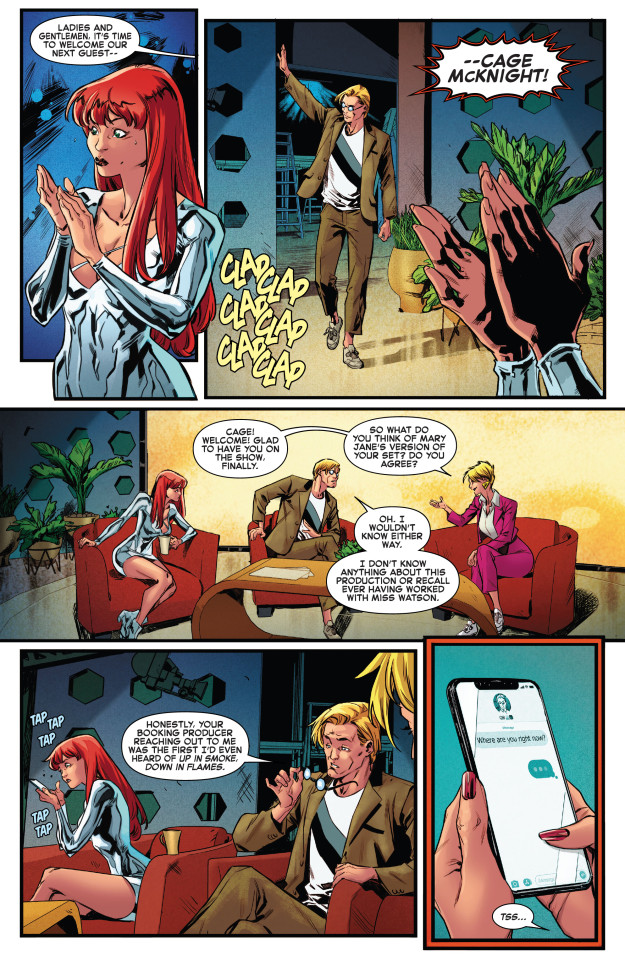
To MJ’s horror she realizes she’s sitting next to the real Cage McKnight who’s returned from his penguin expedition. Reilly asks why he came on the show if he doesn’t remember movie. Cage responds that just because he doesn’t remember making the movie doesn’t mean he didn’t. he explains that in the past he’s made movies in ‘artistic fugues’ and presumes this is just one such time.

*pinches bridge of nose*
Oh my Gooooooooood this is so dumb.
I get the desire to have humour in a story for the sake of levity. But the world of Spider-Man is not even remotely a borderline Deadpool or Harley Quinn or Lobo comic book. The humour doesn’t come from absurdity or a cartoonlike breaking of logic and reality.
And make no mistake, this is absurd. Scratch that, it’s contrived to the nth degree.
First of all I’m not that well read up on fugue states so I briefly consulted Wikipedia who had this to say:
Dissociative fugue, formerly fugue state or psychogenic fugue, is a dissociative disorder[1] and a rare psychiatric disorder characterized by reversible amnesia for personal identity, including the memories, personality, and other identifying characteristics of individuality. The state can last days, months or longer. Dissociative fugue usually involves unplanned travel or wandering and is sometimes accompanied by the establishment of a new identity. It is a facet of dissociative amnesia, according to the fifth edition of the Diagnostic and Statistical Manual of Mental Disorders (DSM-5).
-Wikipedia
Basically a fugue state is a sort of similar condition to Dissociative Identity Disorder, more commonly known as having a split personality. Only instead of an individual’s psyche fracturing into different personalities that take dominance, it’s someone’s mind running away with itself and becoming someone else. The individual forgets aspects of who they are and becomes someone else.
A very good example within fiction can be found in the Doctor Who episode ‘The Next Doctor’. In it a man named Jackson Lake suffers a traumatic experience and in the midst of it (through a sci-fi gizmo) absorbs a lot of information on the character of the Doctor. His traumatized mind consequently decides to imitate what it regards as the Doctor.
youtube
What I’m saying is McKnight’s dialogue about his fugues are very probably bullshit unless someone can cite evidence to the contrary.
Using the above description though McKnight has gotten this rare psychiatric disorder multiple times and specifically in conjunction with his job as a filmmaker. Yeah, no. Not buying it and neither should you.
Being a film director isn’t a muscle memory skill you can’t forget no matter what. People with amnesia or Alzheimer’s disease do not forget how to play the piano or how to drive. But directing a movie? There are so many moving pieces to that job that rely upon you knowing how equipment and more importantly individual people operate. You have to bear a shitton of theory in mind too. It is physically impossible to repeatedly have fugues and then maintain that job.
And even if it was, oh my lord, that is the single most contrived thing in this series yet. Are you SERIOUSLY telling me that Mary Jane and Beck and the entire production got this lucky. The guy who’s reputation is what the movie is riding on happens to be someone who repeatedly deals with this incredibly rare mental condition?
Holy shit. That’s Superior Spider-Man levels of contrived.
And yet if you still swallowed all of that it still wouldn’t make sense!
McKnight presumes he made this Mysterio movie in a fugue state right? But he wasn’t, so he would remember his life during that period of time. Meaning that there are lots of public records and personal accounts testifying that he was making the movie at the same time that he knows he was observing penguins.
If you suffer amnesia or blackouts or DID then there are obviously gaps in time you cannot account for. The overwhelming majority of people who deal with those conditions make a point of keeping track of those gaps, for practical reasons if nothing else. So McKnight would know that there isn’t a gap in time he can’t account for and certainly not for the time period the Mysterio movie has been going for.
Shit, the movie is still filming! How the Hell does he believe he is still making this movie in a fugue state if he’s consciously aware of lacking any knowledge about it?
Not to mention if he’s been in the Falkland Islands this whole time. A quick Google search informed me that by plane it’d take over 14 hours to travel between the islands and Los Angeles. How the fuck is anyone supposed to ever commute that distance, let alone regularly. And McKnight sincerely believes he was doing both at the same goddam time?
You couldn’t even argue that McKnight believes he made the Mysterio movie before his penguin expedition. Because the movie is still being made and all his other ‘artistic fugues’ would have a movie as proof of what he was doing during the fugues.
This is just mind-numbingly stupid and lazy writing. It smacks so hard of Williams trying to desperately paper over the holes in her initial story.
More importantly, how fucking stupid is Mary Jane or Beck to never considered this possibility? I don’t mean the fugue bullshit, I mean the idea of McKnight just coming back from his penguin adventure.
Was Mysterio honestly so incompetent as to have never accounted for that? He seriously never had anything in place to make sure McKnight wouldn’t just decide to cut his journey short? Jesus, and I was dumb enough to buy his line about McKnight spending a year with the penguins.
Even putting that aside, what the flying fuck was MJ and Beck’s plan for when he eventually came back in the first place? Say he really did spend a year with the penguins then came back to the USA. Suddenly he has a movie with his name attached to it and lots of controversy. Let’s say McKnight’s fugue bullshit added up, there is no indication MJ or beck knew about them. So how the Hell were they planning on getting away with the obvious questions he or his friends or family would have had?
And if they did know about the fugues, why didn’t Williams address that before? That was kind of a lingering question hanging over the story until now wasn’t it?
God I can’t believe I paid for this!
On the next page MJ spots a guy in an Oni Mask backstage. She presumes he’s there to scare her as part of the show. However, she notices that the P.A.s haven’t seen him. Meanwhile Reilly set up a stupid game for them to play.

I got nothing to say about this page beyond McKnight’s dialogue. Williams is clearly trying to frame the real McKnight in a less than sympathetic manner. There could be many reasons why. I suspect one of the reasons is to incline us more towards Beck’s version of McKnight and to make us not feel as bad about Beck (and MJ) exploiting his identity.
Because being vaguely and lightly sexist means you deserve to have your career, public image, sense of self and life violated and damaged I guess?????????????
As Reilly brings in people from the audience to compete against McKnight and MJ, the latter thinks that there is something weirdly familiar about the Oni-masked man.

I have little to say about this page too.
Reilly’s attitude and facial expressions make me dislike her, even beyond her stupid haircut.
And as for the Oni-Masked man (I’ll just call him Oni for now) my only guess is that he’s affiliated with Mister Negative somehow. He had his goons wear Oni masks at times. And MJ interacted with them and Mister Negative himself in the popular 2018 Spider-Man video game by Insomniac; and it’s adapted comic book City at War. As such perhaps Williams is trying to tie-in or capitalize upon audience familiarity with that.
As MJ plays the dumb game he ponders if Oni could be a lesser member of Peter’s rogue’s gallery. Observing him again she notices him murder a civilian.

The dumb game annoyed me, but that’s just me.
Beyond that all I can say is that MJ’s dialogue about Peter’s rogue’s gallery is interesting. It proves that MJ has at least a working knowledge of Peter’s major foes. Which just further proves she would have been familiar with Mysterio and his crimes, just in case anyone was still clinging to the idea that she wouldn’t.
Also, the art and especially that splash page were beautiful.
Unfortunately for MJ, Oni notices she witnessed his crime. MJ is nervous and backs away in fear, annoying McKnight when she bumps into him. Meanwhile Spider-Man swings across town yelling for to hold on as he is on the way.

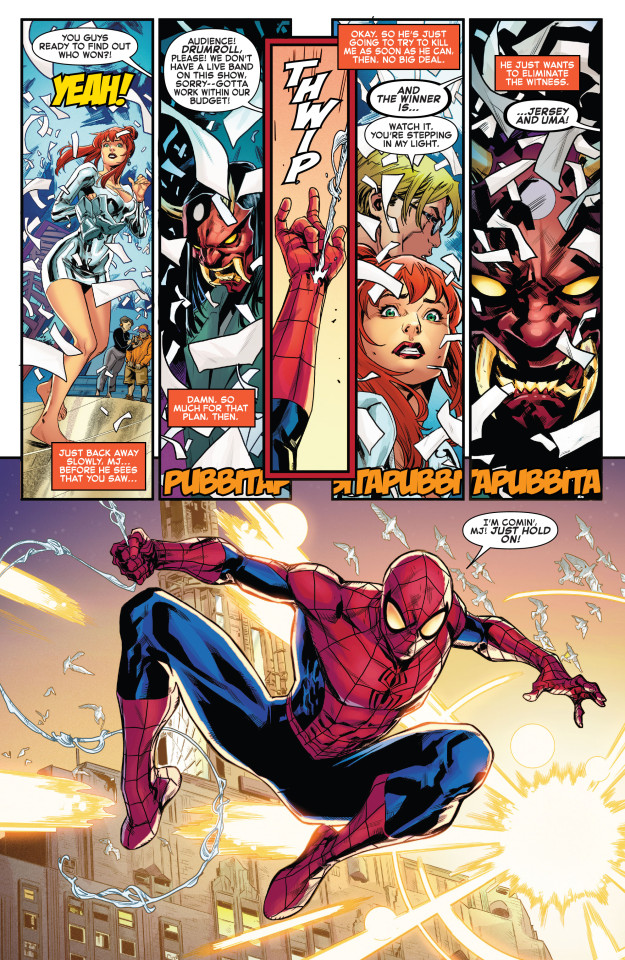
Gomez draws a nice Spider-Man.
Anyway, more of Williams making us dislike McKnight, see above for more on that.
MJ backing away in fear has me apprehensive. I don’t know if that’s in character for her. I guess the shock and surprise could’ve thrown her for a loop. And if Oni doesn’t notice her then it gives her a better chance of raising the alarm and capturing him.
I must say, I do like MJ being on the backfoot here after issues #1-5 made her often overconfident and over capable at times (see her nonchalance over the Savage Six in issue #5).
Also, isn’t MJ going to give Oni the benefit of the doubt? Maybe he’s sorry for murdering that guy just now. Maybe he wants to make amends by creating a movie about his life. So why is MJ so scared?
Sure, he just murdered someone, but what is that next to the laundry list of Beck’s crimes?
As it turns out, Spidey wasn’t on his way to save MJ. He was in fact en route to a French restaurant to have dinner with her. He is actually before MJ for a change.
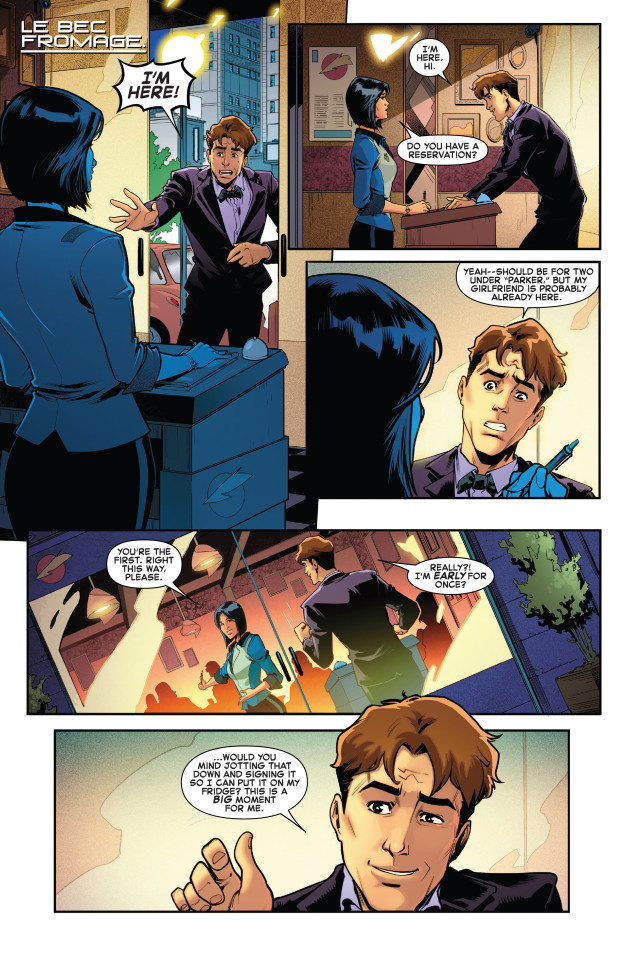
I know Gomez isn’t the only artist on this issue and this doesn’t look like his work. Who ever is drawing it though is doing a very bland depiction of Peter with a overly wrinkly forehead.
The joke about him arriving first for a change was funny though.
Back at the studio, the show wraps up. McKnight insults Reilly’s profession just in case you’ve not realised he is a jerk yet. MJ thinks about persuading everyone to evacuate and searches for her phone. She notices Oni leaving and decides to leave her phone behind.
I already know MJ is going to pursue Oni herself. The stupidity of that aside why the fuck wouldn’t you grab your phone before doing that? You could use it no matter where you wind up and it wasn’t so far away that he’d get that much of a head start.
In fact, if Oni knows MJ is a witness why did he bother hanging around in the first place.
And why didn’t MJ raise the alarm immediately, the worst that would happen is the guy would run away. He’s just stealthily murdered someone and is in a mask. He obviously isn’t going to take the audience hostage, so if her priority is protecting innocents then raising the alarm immediately (or in fact earlier would’ve been her best bet. Yes that’d probably mean he’d have escaped but unlike with say Peter’s origin, getting him the Hell out of there would’ve reduced the immediate threat to the civilians present.
And on top of that if she figures he’s targeting her because she was a witness to his crime then by alerting everyone to his actions she’d have removed his need (at least for the moment) of sticking around to eliminate her, thus getting him away from the audience.
If he’s leaving anyway, MJ could also just grab her phone and put a call in to Peter, her super hero chums or the police and get them on the case immediately. If she was really so determined to go after this guy herself she still could but would’ve had a back up just in case he escapes or kills her. If she fails then she’s insured someone will still pursue him.
And as I copiously detailed in parts 19-22, MJ is not a super hero (and she knows that). She has no idea what this guy’s skills, weapons or powers might be, nor does she know what resources or assistance will be nearby to enable her to survive or subdue him. This isn’t like an armed cop, a martial artist or a super powered person going after a regular crook. She really doesn’t know what she is in for. Even if he is just a normal man, he clearly has a height and weight advantage over her, is obviously willing and capable of chocking a man to death and is armed. MJ meanwhile has little self-defence training, no weapons and hasn’t got the weight or muscle capable of taking him on if she’s backed into a corner. And she’s pursuing him back stage where presumably there is a fair chance of encountering many corners!
I understand that she doesn’t want to endanger innocent people, but there is no point in risking her life there is a much more practical and likely to succeed option available to her. Live to fight another day and all that. Yes the guy might hurt people during or after his escape but that’s a lesser evil vs. going after him herself when she is very unlikely to subdue him, far more likely to die and then the guy will get away without her having passed on any valuable intel on him to someone more qualified to pursue him.
Also once she sees the guy leaving she could just tell everyone the situation and ask the audience to stay put.
Basically if raises the alarm right there on stage and/or calls Peter or the authorities she is over all putting less people in danger and increasing the chances of the guy being apprehended in the long run. But no, instead she is going to gamble on the far slimmer odds that she can capture the guy.
Not to mention, why would the guy even give a shit that MJ saw him? Why would MJ give a shit that she is a witness to his crime? He is wearing a mask! She couldn’t identify him even if she went to the police. It is literally part of the reason her goddam boyfriend wears a mask!
And by the way, are there no security cameras backstage? Wouldn’t MJ consider that or Oni himself?
McKnight apologises to Reilly (so not that much of a jerk I guess) as MJ pursues Oni (barefooted) backstage. As she does this she rehearses what she will say to Peter in her head. This entails telling him that she had to get away from the killer. As she is thinking about this the body of Oni’s victim is discovered. Backstage she comes face to face with Oni who refers to her by name.
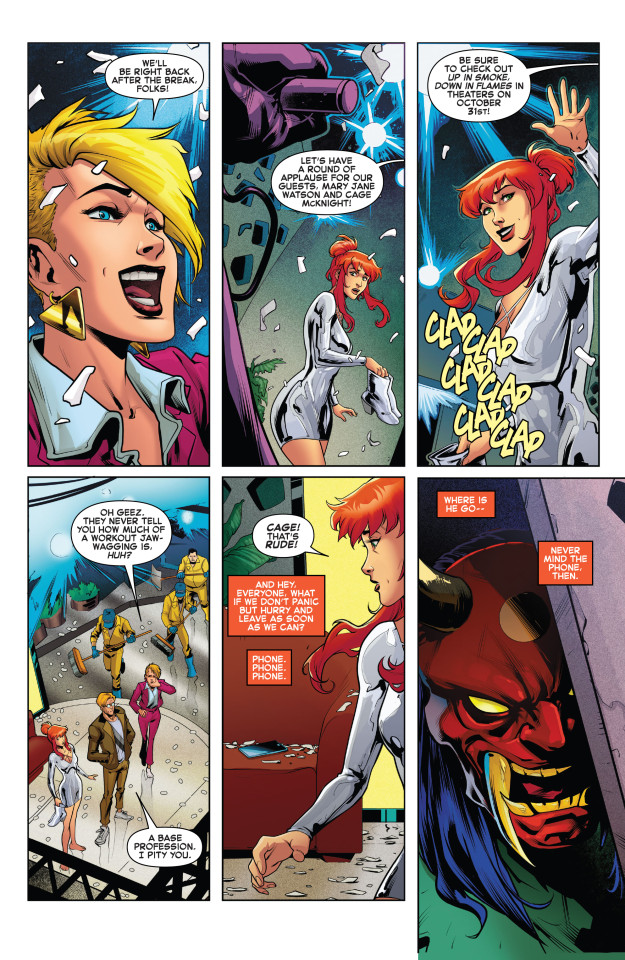

Yay. MJ deliberately planning on lying to Peter again. It’s so awesome that Williams understands why this isn’t a really bad idea for the reasons I pointed out in part 17.
By the way, I suspect Oni knows MJ personally rather than just recognizing her work.
I’m actually going to leave it there for now as the next part of the story has a shitton to unpack.
Previous Part
Next Part
Master Post
#Leah Williams#Amazing Mary Jane#Mysterio#Quentin beck#Spider-Man#mary jane watson#Mary Jane Watson Parker#mjwatsonedit#MJ Watson#peter parker#Doctor Who
15 notes
·
View notes
Note
Hey, you mentioned in an earlier ask any Damian that Tim was also low-key sexist and tbh I'd love examples cause I feel like this has never been brought up and it's interesting??? Anyway, thanks Ur stuffs super interesting and insightful!
Thanks for your interest & nice words!
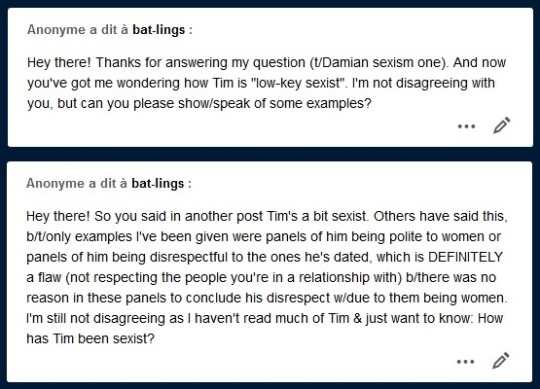
Let’s be clear tho Anon (I assume it’s the same Anon both times?), you are 200% entitled to disagree with me. Yes I am unapologetic about my opinions and write looong paragraphs of questionable pertinence to give arguments but like. The goal is to explain “why I think what I think,” never to tell you “why you should think what I think”. You’re very much welcome for the Damian post btw
Now I think Tim, precisely, shows internalized sexism. Doesn’t change the end result all that much though.
Random sequences
Let’s get the most straightforward stuff out of the way.
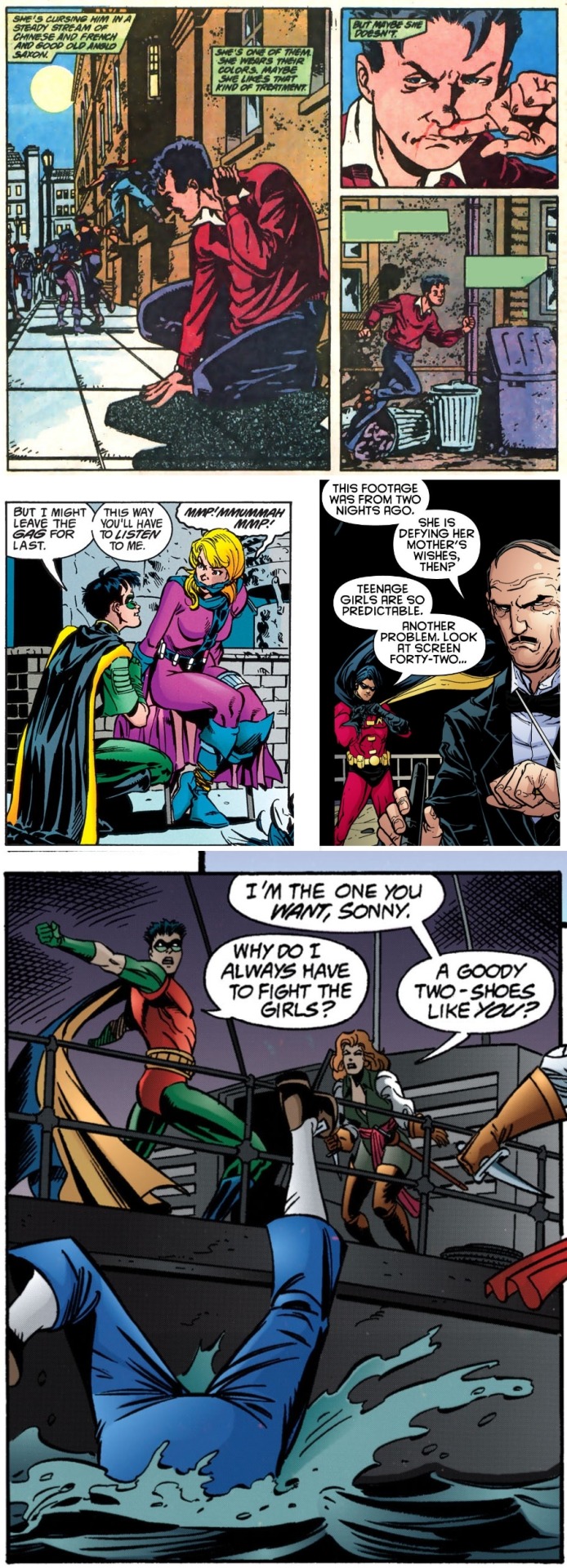
[Robin (1991) #1 || Robin (1993) #43 & #179 || Detective Comics (1937) #687]
Dunno about you but the first two are particularly cringey for me. That and the agenda section.
Okay to be fair: He does attempt to defend Lynx (first example) beforehand, throwing the on-point “she doesn’t have to go with you if she doesn’t want to” line. All is good for five seconds and then he goes “maybe she likes that treatment”.
We may have different sensibilities but the mere fact that that went through his head for even a second is the perfect illustration of what’s internalized sexism imo. Conscious thought & action level: A+ behavior (being able to identify a visibly wrong situation and taking action against it). Unconscious level: blatant sexism (”maybe she likes it” aka a less visible/more subtle manifestation of bigotry).
He has a… pretty specific way to regard women’s agenda. And is overall patronizing to straight-out disrespectful.
Tim’s treatment of Steph is a well-known fact but this is a call-out post so have a non-exhaustive bunch of examples:

[Robin (1993) #4, 41, 35, 44 || Batgirl (2009) #8]
On we go and see how there’s absolutely no ill-intent on Tim’s part in the next examples, yet I have a big problem with how he’s considering the ladies’ agency:
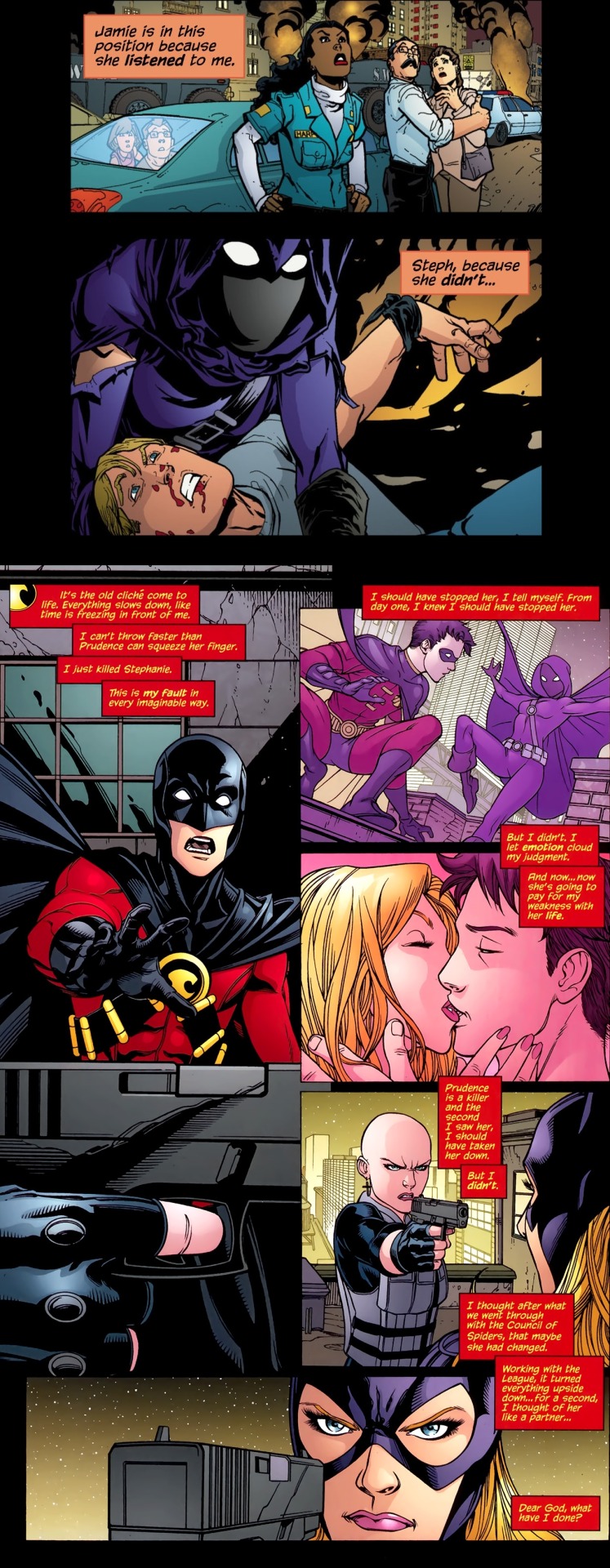
[Robin (1993) #182 || Red Robin #10]
Notice how it’s all about him whether the lady obeys him or not. His failure to impose the necessary authority or his failure to give the right directions. The girls’ choice/independence just doesn’t factor in. It’s a cop and a vigilante we’re talking about, not some civilians caught in the crossfire.
((btw it’s disputable but his apology in RR#10 is too little too late as far as I’m concerned. Tim gets a pass since Nicieza has him referring to his dumbass traitor!Steph arc but he doesn’t deserve any additional credit either. Okay no I’m being mean, he gets kudos for making a step in the right direction with Steph. Tiny kudos. It’s a tiny step.))
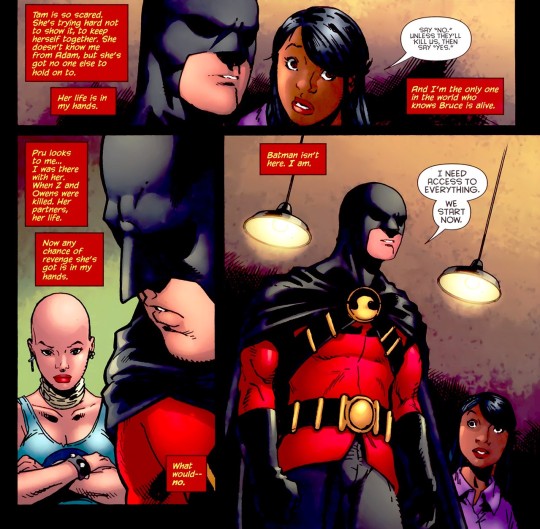
[Red Robin #5]
Tam? Okay. She’s the civilian who got embarked into this crazy story, she is in need of saving. But Prudence? Maybe don’t automatically assume that the assassin needs you to pat her on the back to even consider pursuing her own wishes, Timmy.
Tim can be arrogant to everyone yeah (more on that later), but I don’t remember him negating a man’s agenda like that.
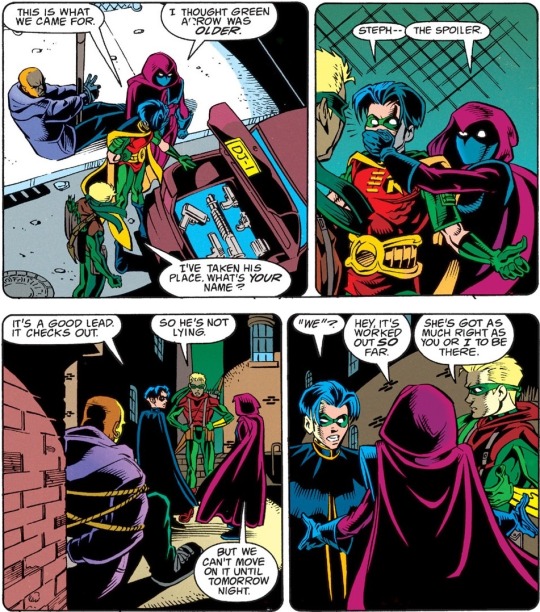
[Robin (1993) #25]
Yeah the kid who will feel betrayed when Bruce tells his identity to Steph just elected to tell her name to Connor whom they both don’t know well yet. While talking in her place rather than letting her answer for herself (something he’s done on several occasions). Then he attempts to decide for her whether she has a right to participate, again. On that note: thank you Connor for putting Tim in his place, that sure doesn’t happen often.
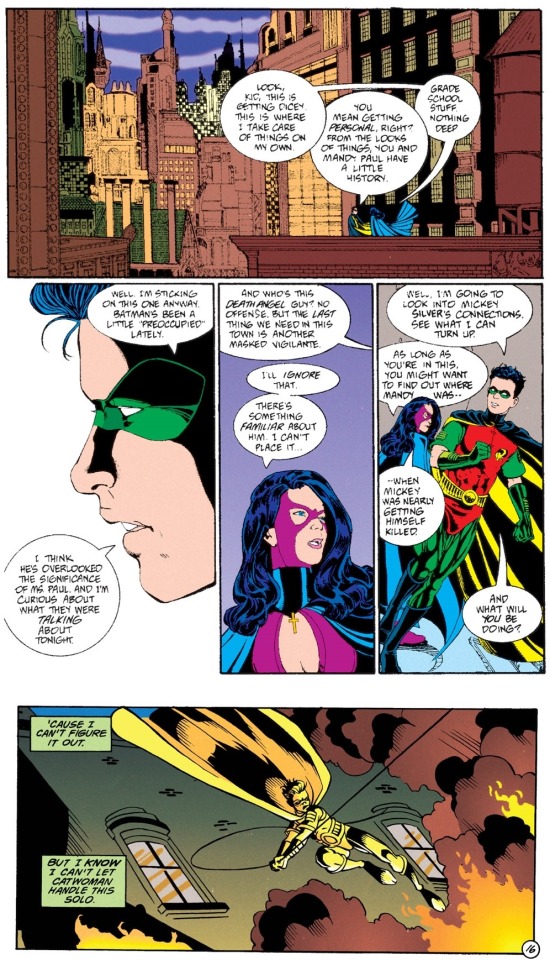
[Robin (1993) #6 & #28]
Uh, yes you can. Give the adult woman who’s been handling Gotham’s streets since before you were born some credit, Tim?
As for Helena, the scene in itself is… well, not okay exactly. He’s basically dismissing her wish to handle a personal matter alone, which could imply he doesn’t think the other adult woman who’s been handling Gotham’s streets since before he was born can handle the case.
I’m just putting it with his constant attempts to keep Steph from participating, often to cases that concerned her directly, and how he tends to take it personally when she doesn’t obey… but he casually brushes off Helena when she’s saying she’ll handle a personal case alone. Double standard? Maybe I got too specific a reading but. I don’t remember that sort of thing happening between Tim and male characters– do call me out if I’m remembering wrong though.
And then there’s the “another vigilante” remark.
Anyway yes Tim can be arrogant towards both men and women. Much like Damian being antagonizing to everyone didn’t negate the possibility of him being sexist, Tim being generally arrogant doesn’t negate that possibility for him either.
Plus the only male characters I’ve seen him be that patronizing with are Chris Kent in World’s Finest #3, and Damian. The ten-year-old who’s regularly antagonizing him and does deserve to be put in his place. Oh yeah, and maybe Dodge, another brat. So yeah I do think there’s a slight difference between Tim’s treatment of men and women, if only in frequency. (and in intensity tbh.)
Yes, he’s been consistently disregardful to his girlfriends.
Anon, you say very rightfully that we shouldn’t automatically assume it’s due to them being girls. Please believe it’s not a conclusion I’ve come to automatically though:
A) While I realize that Tim only having canon girlfriends is due to heteronormativity & homophobia rather than a conscious writing intent to highlight any character trait, assuming that he wouldn’t have behaved better with boyfriends is pure speculation– aaand I am totally speculating he’d behave better if only because he’s never that patronizing or that dismissive of his peers’ agency (examples above) when they’re men. that’s part of why I ship tim/kon more easily than tim/steph.
B) Like with everything I brought up on this post I’m not considering his behavior with his romantic partners separately. It’s a character fault that could take its roots in several things, but Tim’s global characterization makes me think the root is sexism.
C) I understand why you’re thinking there’s no reason to conclude his disrespect is due to them being women; in the same vein I think there’s no reason to conclude it’s not. It’s kind of a stalemate and both conclusions are valid.
Skipping Tim’s habit to break up by letter or by phone, ‘cause that’s not cool and obviously disrespectful but even I think it’s more due to cowardice/inadequacy than sexism.
I don’t think I need to speak about Steph again. Let’s go with Ari. Who Tim casually cheated on by kissing Steph on several occasions.
Being a cheat is, in itself, a distinct character flaw that doesn’t always takes its root in sexism. Plus it’s something I have my reasons to assume Tim has grown out of.
It’s his reaction when he learns about Ariana “"cheating”“ on him (she went ice-skating with another dude once in the 87 times Tim stood her up) that ticks me off. Btw and unlike Tim who didn’t seem to feel all that guilty, Ariana did try to tell him about it but he fell asleep during her confession.
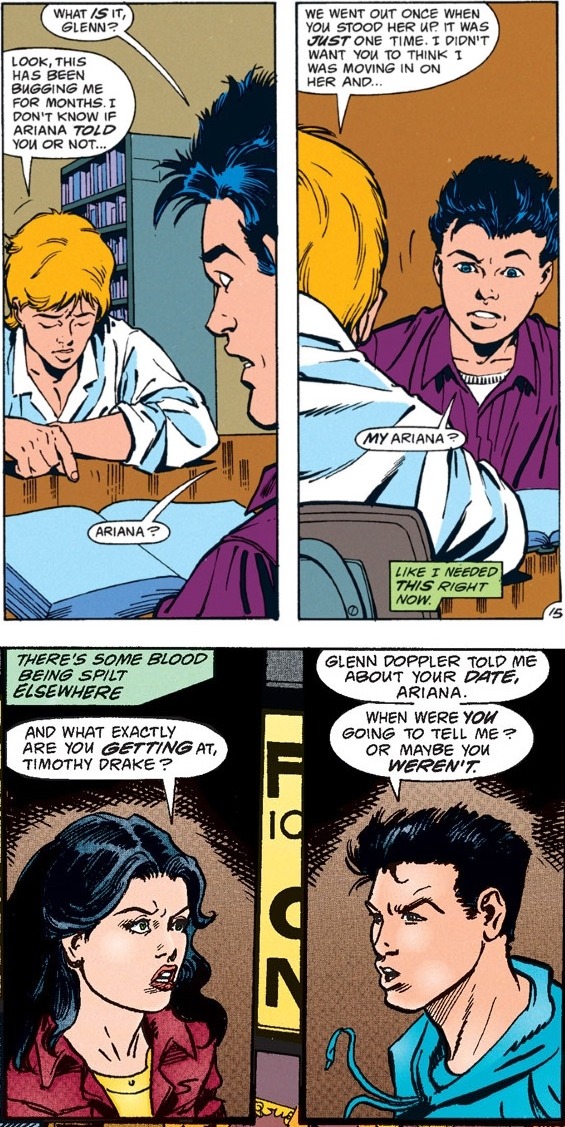
[Robin (1993) #15 & #17]
Two things bother me here, a lot more than the cheating in itself: the possessiveness and the hypocrisy. You really don’t have a right to go all “My Ariana” and to chew her out for the grand treachery that is ice-skating when you’ve been casually kissing Steph, Timbo. What those panels prove is that there’s a double standard in Tim’s head. Which one exactly is up to your interpretation and that’s probably where we’ll end up disagreeing. I read it as the “proper girls don’t get close to several boys at one time, but boys who get close to several girls are either ladies men or boys being boys” double-standard, hence Tim’s blatant lack of self-awareness here.
Btw and the thing that solidified my opinion here: Tim, as a rule, tends to be pretty self-aware, at least retrospectively. He puts himself into question and has no problem admitting when his judgment was clouded. I dunno take YJ #55 or Robin #119 for example (I even selected examples that both have Tim recognizing he wronged a girl!)
So if he’s generally self-aware, but doesn’t see anything wrong with his own behavior in the specific situation where he’s cheating on his girl then chewing her out? I explain it with the above double-standard. He internalized a mindset that keeps him from realizing how hypocrite he’s being in this situation. Also he doesn’t confront Ari immediately, he had time to think about it, it wasn’t a spur of the moment thing. That should’ve been enough to allow him to step back and evaluate himself but he just. Didn’t.
Bonus: Jack has been hinted to be sexist, and contrary to Tim it’s safe to assume that was totally intentional.
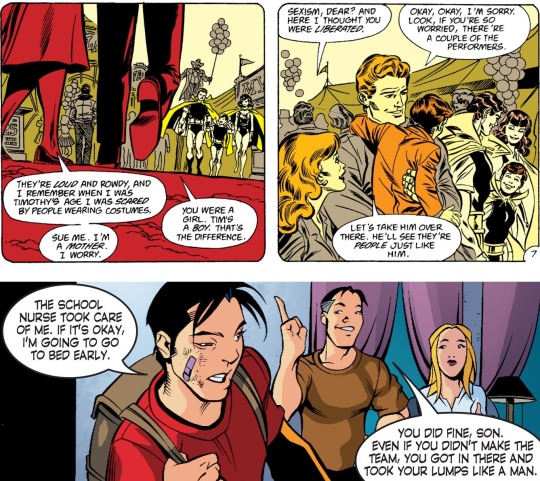
[Batman (1940) #441 || Robin (1993) #122]
Only two occurrences in decades of canon arguably don’t make for solid basis but they still allow me to build a coherence since our parents do influence us without us realizing. And given how much Tim loved his dad (he said himself how much he got from Jack), it sure isn’t an element that could plead against him being sexist.
.
There’s a bunch of other sequences that I low key read as sexist, but that I’m more mitigated about or in which I gave Tim a pass for various reasons so I didn’t include them here.
All in all when I take a solid look at Tim’s global behavior, I see sexism. While it may not be a “solid canon fact” since it surely wasn’t intentional on the writers’ part, I really don’t think it’s an unreasonable thing to infer from his very canon behavior. And tbh writer intent doesn’t excuse much. Factually speaking that portrayal has been there since Tim’s early days,he’s been consistently dismissive & disrespectful of his female peers and/or of their wishes and agency. It’s part of him & his history.
It’s not incoherent with his character either– Tim has always been intended to represent a normal boy/teen (dude was legit marketed around the fact that he’s relatable). It’s not baffling or coming out of nowhere that a random teen just so happened to have internalized sexism. It’s pretty damn common, even. It’s not like Tim being sexist was a brutal turnaround that contradicted what makes the core of his character to the point of making him unrecognizable (*cough* Talia’s current characterization *cough*).
Hope this explains that.
Thanks for the asks!
#tim drake#dc comics#stephanie brown#batfam#batfamily#meta#red robin#timothy drake#tam fox#asks#zae chatters#my stuff
84 notes
·
View notes
Text
On Pink Pearl Thus Far
I had to re-post this because tumblr is trash and if I include any hyperlinks this won’t show up in search at all. 🙃
(Note: I’ll be referring to ‘White Pearl’ and 'Rose Quartz’ by their original titles of 'Pink Pearl’ and 'Pink Diamond’, respectively.)
HOO BOY. I stumbled upon @ask-whitepearl-and-steven just a couple months ago and, just… wow! This is an absolutely amazing fanwork, I’m utterly floored and grateful that @thechekhov is willing to dedicate the time and effort it takes to make and share this story.
For those of you who haven’t read it, Ask White Pearl and Steven is, reduced to it’s most base description, an AU where Steven’s mother was White Diamond and Rose Quartz still leads the Crystal Gems.
You can read the comic in full at
https://tapas.io/episode/1242681
You can follow the blog itself for more content at
https://ask-whitepearl-and-steven.tumblr.com/
You can follow the creator’s blog at
http://thechekhov.tumblr.com/
You can support the creator at
https://www.patreon.com/TheChekhov
Why is it so great? WELL!
The characterization is well thought-out and well presented;
The style is true to the original but still definitely it’s own thing;
Colors are utilized sparingly, which makes it pop all the more when they’re there;
I definitely appreciate the fact that this version of Steven looks his age, and that this version of Steven is more prone to questioning the world around him, all due to his upbringing (or lack thereof);
It’s nice to see Connie and Steven still having a fantastic friendship under different circumstances;
And, of course, getting to see Steven and “Rose” interact is just 👌👌👌
Plus, the foreshadowing to the latest reveal was faaaaan-tastic! I won’t go into detail here, ‘cause if you’ve read it you know what I’m talking about, but… just keep in mind that the characters’ eyes changing color isn’t just a stylistic thing.
So, with the end of S2, I wanted to post some speculations! Specifically about Pink Pearl, what she’s been through so far, how deep the Bleaching goes, and how she might feel as of the latest update.
Warning, this is a doozy of a dissection / theorization post. Get a snack.
(Note: Any time I say ‘order’ or ‘command’ here, it’s in the context of ‘Pink Pearl’s bleaching causes her to consider this an order’, not ‘Steven is ordering Pink Pearl around.’ I wanted to clarify just in case.)
First off, Bleaching. What is it, even?
Well, ‘Bleaching’ is what I call the primary half of White Diamond’s power; the other half is ‘Replacement’. The latter requires the former to work. How the heck did I come to this conclusion?
For one, her direct quote on the matter, “There we are, I’ve removed their flaws! Now, there is nothing to hinder my white light from sparkling through them!”
This implies that Bleaching is the precursor step to Replacement, and that they are not the same thing even though they work in tandem.
And we can see this for ourselves; in the scene in The Head Ship where White Diamond blasts the Crystal Gems, their personalities aren’t immediately overwritten. The stay on the ground and struggle weakly for a moment while White Diamond continues to monologue.
I Bleaching is essentially re-organizing the internal structure of the Gemstone to get rid of structural impurities and neutralize any foreign-particle impurities that absorb light-waves. I can imagine that it’s very painful to have the very core of your being rearranged and ‘purified’. If they had been allowed to get back to their feet in this state, they still would have retained their personalities… but, they would have been compelled to follow White Diamond’s orders, direct and indirect, to a tee.
But, now that the Gems’ colors have been “fixed”, and now that White Diamond’s light can fully pass through them without being altered by impurities, White can progress to part two of her ability, Replacement. With a snap of her fingers, White Diamond’s light overrides her victims’ light, and, well… Gems are light. So now, they are White Diamond.
But… what happens to a Bleached and Replaced Gem when White Diamond is no more? If White Diamond were to be shattered, the Gemstone that powers the Bleaching/Replacement would be rendered inoperable, and the effect would cease, of course.
But, in this story, that’s not what happened. White Diamond the person is gone, but White Diamond the Gemstone remains. The Bleaching remains, but her “unhindered light”, the Replacement (more on that later,) is no more.
All that being said, I believe that this version of Pink Pearl is fully aware of her surroundings, and still retains her own individuality and personality while Bleached, although her ability to show it is severely hindered by the Bleaching.
Steven is currently under the impression that he’s been controlling Pink Pearl in a similar fashion to White Diamond. He thinks that he’s been projecting all his emotions onto her, and all her emotional reactions have merely been a reflection of what he desired to see.
It’s easy to assume this is correct, now that we know the white-pupil-glow means he’s issuing a command to Pink Pearl, but this couldn’t be farther from the truth! Early on, we have seen Pink Pearl emoting subtly via the sweat droplets she sometimes gets when Steven is displaying his ignorance of both his and her origins.
Here’s an example of her being obviously sad, when, if Steven were truly projecting his emotions onto her, she should be acting optimistic to alleviate his worry for her:

Later, we even see her with white pupils, emoting on her own:
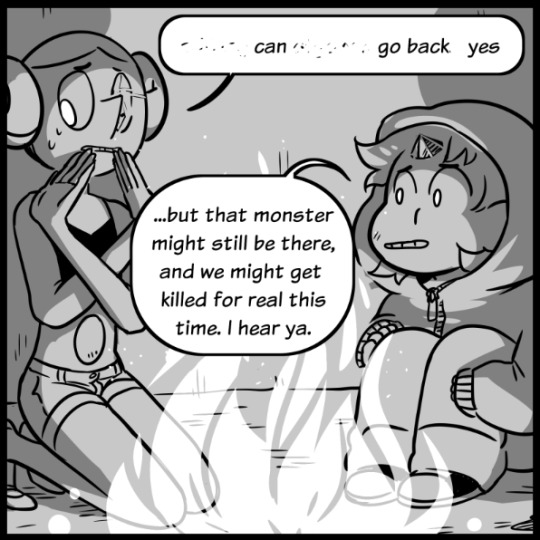
It’s implied that, although she’s being ordered right now, her expression is her own and not reflective of Steven’s expression, since he had no reason to grimace until he deduced why Pink Pearl was grimacing.
Pink Pearl has also been shown, multiple times, to take (limited) initiative without being directly ordered to. The best example of this is during the Mystery Canyons scene.
When the Teal Gem Monster made her first appearance, Pink Pearl made a mad dash for the transporter, despite the fact that Steven was dead-set running away on foot. If he had truly been ‘talking to himself’ this whole time, she would have followed without question.
But, Steven wasn’t issuing any direct commands, so Pink Pearl was able to take initiative and find a better way out. She wasn’t able to activate the transporter on her own until indirectly commanded to, though.
During this scene, she was visibly distressed about the danger and confused that the platform wasn’t working for her (likely a limitation of her Bleaching, or possibly a limitation of whatever made her eye-crack.) Her pupils were grey, not white, so these were definitely her own feelings, not Steven’s.


Shortly after they arrived in the Pit, Pink Pearl did the Diamond sign in response to Steven’s question about who the Giant Ladies on the four murals are. She then took initiative to salute and bow to Steven. This could arguably have been Bleached into her, but I think she was trying to communicate to Steven about his origins, given that his eyes were normal-colored.
We even get to see some of this in the way she echoes Steven:
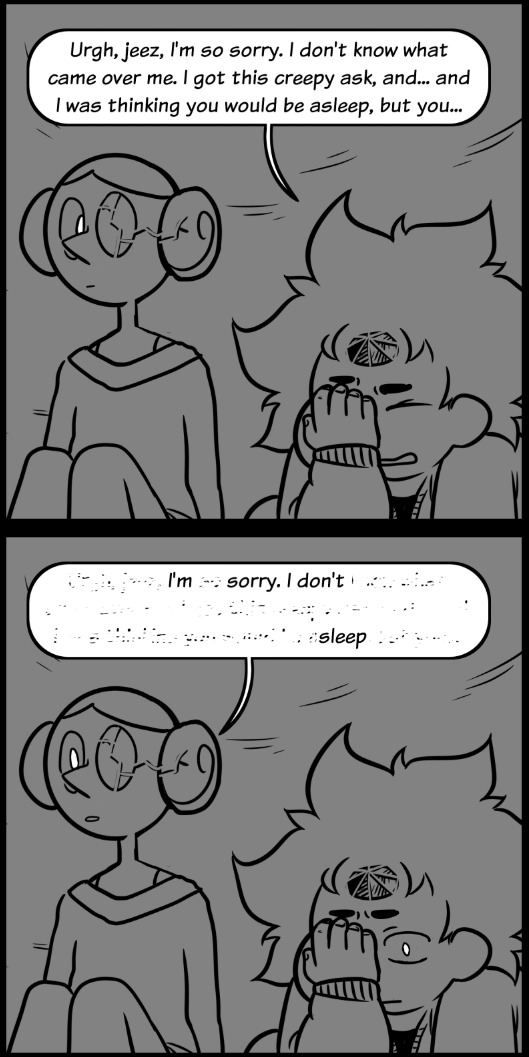
If Pink Pearl was mindlessly providing the information requested of her, or heck, even if she disliked Steven, she would have simply said 'I don’t sleep’. However, she can tell that her inability to sleep is causing Steven distress, so she says, 'I’m sorry, I don’t sleep.’
Finally, when it comes to orders and commands, Pink Pearl’s perception overrides Steven’s intent.
Pink Pearl has been a servant to White Diamond for thousands of years. She is very sensitive when it comes to being ordered around; most orders are not direct. Much of it is subtle, ex., if White Diamond were to walk up to a door and Pink Pearl did not open it for her, that would be violating a command, even though no command was spoken, because of Pink Pearl’s position of servitude.
The white-pupils are a two way street; they originate from Steven when he, for instance, asks a question that he expects some for of answer to. They originate from Pink Pearl whenever she interprets something as a command.
We can see an example of this here:
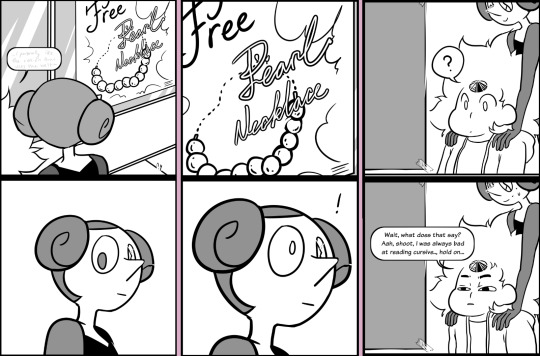
Steven has been trying to figure out Pink Pearl’s name. Pink Pearl perceives this as an order to tell him her name, which she can’t do. This sticks with her as an unresolved command.
In this scene, Pink Pearl’s eyes are normal until she realizes she can use the sign to communicate with Steven. Then they become white, because the unresolved command kicks in. Steven, meanwhile, has been looking at clothes, but his eyes still turn white even though he’s not initiating interaction with Pink Pearl.
All of this, is the effect of Bleaching.
But what of Replacement? Well, that’s not just a White Diamond thing…

Steven can do it too, in his sleep. Steven is not made of light, so it stands to reason that projecting his consciousness is the closest he can come to emulating White Diamond’s Replacement ability. He can only do this with Bleached Gems, and there’s only one Bleached Gem we know of.
So, the following is established:
Pink Pearl must follow anything she perceives as a command, direct or indirect, that come from the owner of White Diamond’s Gem.
Pink Pearl is unable to say her own words; she must repeat those recently said by Steven, in his own voice.
Pink Pearl can pick and choose what words to say, as long as she fulfills perceived commands in the process.
Pink Pearl can take initiative, as long as she is doing it in that name of a perceived directive.
Pink Pearl’s personality is no longer being Replaced with White Diamond’s, or Steven’s, for that matter (when he’s awake and not unconsciously doing it.)
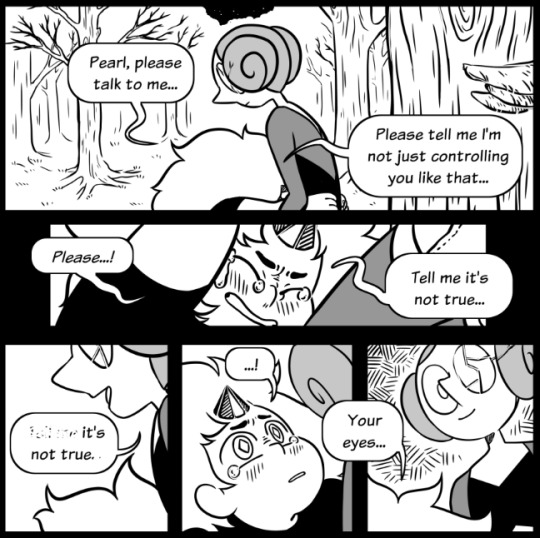
Steven kinda played himself here. “Please, tell me it’s not true!” is a direct command to do just that. However, it is also partially true that he’s not “just controlling [her] like that,” because he’s not the one that Bleached her, he only ever took control of her body to guide them back together, he obviously never intended to force her to do anything, and it’s her ingrained sense of what a servant is expected to do that keeps triggering the Bleaching-forced-compliance effect. Plus, she still retains her sense of self and a limited ability to assert it.
From what I’ve observed, Pink Pearl is not stupid. She realizes, at this point in time if not earlier, that Steven and White Diamond are wholly different beings, even if she’s doesn’t know the 'how’ or 'why’ of it (does she??). After interacting with Steven for a few weeks, Pink Pearl probably also realized that Steven was wholly unaware of the control he was exerting over her. Any doubts she might have had would have definitely been quashed when Steven started to have a meltdown over the revelation.
All of this is probably what’s going through her mind as she says this, so she doesn’t immediately realize that she just confirmed Steven’s worst fear.

And then it hits, and she realizes precisely what was wrong with her response. No white pupils here, those tears are inarguably her own.
Suddenly, Steven accidentally manages to give her back the ability to act of her own accord, before he passes out from the stress and/or the effort he exerted partially reversing the Bleaching his mother did.
And what’s Pink Pearl’s first response? After a brief moment of ‘what the frack just happened’, she scoops up Steven and carries him to his father. Which implies that she already knew where he lived, and that as soon as she got Steven’s “Beach City’ message, she knew she needed to find a way to get them back together.
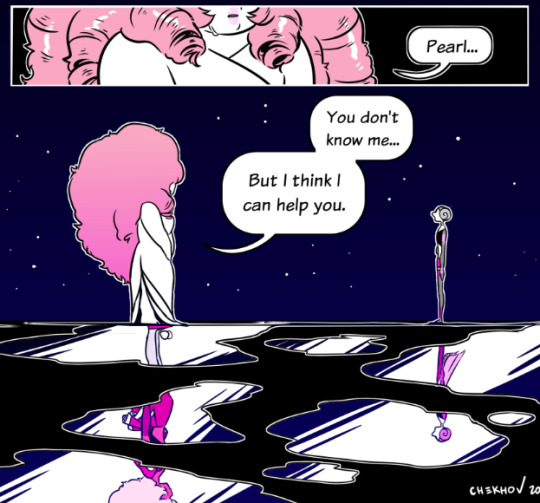
So, where does this leave us?
Well, in canon, it’s been shown that Replaced Gems don’t remember what happened while they were being Replaced. This both means that Pink Pearl blacks out when Steven takes her over, and that she does not remember anything that happened while she was Replaced by White Diamond.
From way before the War, to the beginning of Era 3, is all a blank to her. It remains to be seen if White Diamond rescinded her Replacement at any point while on Earth / head-preggo with Steven, and/or if she told Pink Pearl anything about the War for Earth.
Possibility One:
White Diamond knew that Pink Diamond was posing as a Rose Quartz. She imparted this information to Pink Pearl before she passed.
Pink Pearl may justifiably feel that Pink Diamond abandoned her. There’s many reasons why Pink Diamond could not go back for her and keep the War going, but all that would not initially matter to Pink Pearl in the face of her Diamond leaving her to a fate of being puppeteered.
Pink Pearl should also be able to extrapolate that Pink Diamond has no way of knowing or even conceptualizing that 'White Diamond’ no longer exists. Without any way to communicate this, any attempts to defend Steven will be interpreted as her Bleaching forcing her to keep her abuser safe from potential liberation.
Possibility Two:
White Diamond had no idea that Pink Diamond was posing as a Rose Quartz; or, she did, and did not impart this information to Pink Pearl before she passed.
Pink Pearl and Pink Diamond’s relationship has been shown to be more of a best-friendship than the master/servant relationship it was intended to be, so Pink Pearl likely holds Pink Diamond on a very high pedestal for her kindness. She probably feels the same way about Steven, at this point.
So, from her perspective, Rose has broken the kindest of the Diamonds, and attempted to hurt the equally kind son of her former abusive master. Rose may say she can 'help’, now, but Pink Pearl knows Steven doesn’t want to hurt her or rule over her, so she may very well reject any help Rose has to offer in favor of letting Steven figure out his powers and finish freeing her on his own.
Either Way!
Pink Pearl may be avoiding Greg for whatever reason, but I doubt she’ll ever be far from Steven, considering that Rose Quartz and the Crystal Gems pose a very serious threat to his continued existence. If worst comes to worst and Steven is killed, it’d be reasonable for Pink Pearl to fear the return of White Diamond.
~THANK YOU FOR COMING TO MY TED TALK~
#this turned out to be six pages in twelve point times new roman without the pictures#ask white pearl and steven#thechekhov#steven universe#su#i swear to god as soon as i have extra money i am gonna throw it at this person for this amazing piece of work just#i cant even with how good it's been thus far#lagtim3 blogs
1 note
·
View note
Photo
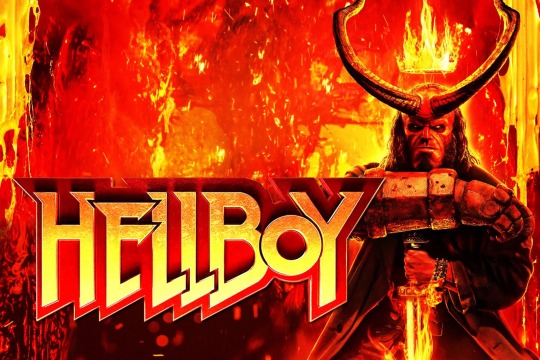
FILM | Hellboy (2019, dir. Neil Marshall)
I’ll start by saying that I’m a fan of the Guillermo del Toro/Ron Perlman interpretation of Hellboy. That’s where I discovered the story (the graphic novels are on my “to read” list) and that’s who I envision as the character. I gave this newer rendition the benefit of the doubt to see where it would go if they refused to give del Toro/Perlman the sequels they deserved and should have gotten. And, just like many other fans, I too was disappointed. Shocking, right? (*soooo so so much sarcasm*)
Through some research – because I could NOT bring myself to believe the this narrative was based on the actual graphic novels in the series – I learned that this Hellboy pulled a large amount of its source material from The Wild Hunt. Ya know, the one where we learn that **SPOILERS** Hellboy is a descendant of King Arthur. Yes, THAT King Arthur, the guy from the Round Table. If you just facepalmed yourself, know that I did too when I saw that on screen. I can appreciate the source material, and possibly could have gotten behind this story as a choice for the film had it been done well, but in this instance, King Arthur just felt so... corny.
With The Wild Hunt, it is also said to source Darkness Calls and The Storm and the Fury and I think this is part of where things went askew with this new Hellboy – it tried to have too many components from too many sources (and it should be noted: the 2004 Hellboy stemmed from Seed of Destruction alone). As I was watching, I felt many times that its was all too disconnected and didn’t have a good flow. It had too many people’s intros and narratives to explain in a little amount of time (I’d say a mere two hours is short in this instance)...
Even listing just the most important, there was still:
Hellboy
Hellboy + Broom
Hellboy + Alice
Nimue
King Arthur/Merlin vs. Nimue
King Arthur’s descendants + Hellboy
Hellboy vs. The Osiris Club (and giants)
Hellboy vs. Gruagach (the pig-fairy)
Major Ben Daimio’s whole mysterious spiel (which was actually predictable)
Baba Yaga
GOOD GRIEF, LOOK AT THEM ALL. Not to mention, much of these narratives were done in a flash/moved too quickly, and mostly got overrun by unnecessarily bloody fight scenes anyways.
Guess what, people who make movies? Giving something an R-rating, uncharacteristic profanity (according to many reviewers who have read the comics, the most Hellboy might say is “son of a bitch”) and adding copious amounts of blood/gore/creepiness does not mean it’s going to be successful. Coherency, story, and character development are equally as important. Don’t just fly by hoping people know the material enough to fill in the blanks you left out. Like I almost felt lucky to know what I know about Hellboy, to recognize that even the likes of his origin scene (where he is taken in by Broom) this time around was immensely understated – which I would say then also underplayed his relationship with Broom. Also, someone please tell me the whole point of having Thomas Hayden Church appear for less than two minutes during this scene as Lobster Johnson. For obvious reasons I doubt there will be a sequel to this movie (they also gave him a post-credits scene setting up that possibility), so it’s such a waste of screen time and took away from details that really mattered.
I do like the idea that Mike Mignola himself (the author of the Hellboy graphic novels) supposedly had a hand in this film, but more truthfully, I wonder how much freedom they actually gave him to create the world he envisioned. Because, like reviewers on IMDb I skimmed, I find it hard to believe that this is closer to Mignola’s own perception of Hellboy. You never know what really goes on behind the scenes, and I speculate that maybe the filmmakers had Mignola help for a metaphoric two seconds just so they could say he played a hand in it. Maybe a ploy to give 2019′s Hellboy more standing and solidity as a film. But what do I know about cinema politics. And maybe I’m wrong, since another critique claims it failed because it was too faithful to the comics... and who more likely to make it painfully faithful than its own creator.
I’m curious if, maybe, had I watched this one with fresh eyes (read: having not seen the previous films), would I have felt any different about it. And right now, I’m sitting here staring off into the distance trying to envision the movie as objectively as possible, pretending I had zero expectations... but it still just isn’t happening for me. While the new, edgier quality feels just as gritty and gruesome as the comic, in my mind there was too much against it. Like, for some reason, David Harbour’s prosthetics, especially around his mouth and ESPECIALLY when he was talking, bothered me. And, while I get that they were really trying to distance themselves from the early 2000s films by employing new sidekicks, it didn’t feel right without Liz Sherman and Abe Sapien (though Abe’s name does make a brief cameo at the end). I almost feel as though Milla Jovovich as Nimue/The Blood Queen was the only casting that really made sense here. Heck, even the music they chose to soundtrack this film fell flat.
I’m not saying I really wanted to like this Hellboy, but I definitely didn’t want to see the story of a character I enjoy done so poorly. I can give props to improved cinematography and effects in the fifteen years since Hellboy 2004, as was to be expected as technology continues to improve. But it’s mostly another reboot ruined by a bad script. So sad.
And to think, this all could have all been avoided had they just given Guillermo del Toro the opportunity to finish his envisioned trilogy in the director’s chair, instead of merely a producer for a third film. Maybe one day Hollywood will figure it out: films will cult followings have the power to ruin your box office numbers. Just give us what we want.
#hellboy#hellboy 2019#david harbour#ian mcshane#milla jovovich#film#films#movie#movies#cinema#quarantine#quarantine entertainment#review#reviews
0 notes
Text
Relist Watch
John Elwood briefly reviews Monday’s relists.
There are so many interesting relists to discuss this week that I’m not even going to try. Who has time to discuss 19 new relists? After all, I’m busy preparing for other pressing commitments, so it’s time once again for the affordable luxury of Relist Watch SelectTM.
As some internet rando put it, “[t]his week’s relists involve the most comically high-profile group of issues I think I’ve ever seen. If they actually granted in all those cases, everyone’s heads would explode.” Allowing for some forgivable hyperbole when you consider the source, the guy has a point: This week’s relists raise some crazy-interesting issues.
For starters, the court has relisted a case sufficiently famous that it can be widely identified by just the petitioner’s name, Arlene’s Flowers. The case is a follow-on to the similarly famous Masterpiece Cakeshop, involving a state’s ability to compel people with religious objections to same-sex marriage to use their artistic talents for such ceremonies. And that’s just the beginning of the high-profile free exercise cases. The court has relisted two cases asking whether it should revisit its holding in Employment Division v. Smith that the free exercise clause does not require religious exemptions from laws that are neutral and generally applicable. If you don’t like either of those, there’s a slew of other free exercise cases. And if the First Amendment’s religion clauses don’t float your boat, there are cases about compelled disclosure of donors that involve associational claims. Some even involve religious organizations.
Then there are the administrative law cases. Interested in overruling Chevron U.S.A. v. Natural Resources Defense Council? Check. How about overruling National Cable & Telecommunications Association v. Brand X Internet Services? We have you covered. Add in a couple of personal-jurisdiction cases brought by America’s third-oldest car company. If anyone thought all those were too dull, we have a couple of cases involving the Affordable Care Act’s contraceptive mandate. And a couple of cases involving so-called “faithless electors” who vote in the Electoral College contrary to the popular vote in their state. Then there’s a grand jury secrecy case. And a case involving foreign official immunity that requires a [Disclosure: Arnold & Porter Kaye Scholer LLP, whose attorneys contribute to this blog in various capacities, is counsel to the petitioners in this case.] And a double jeopardy case. And an immigration case filed by the Trump administration. Oh sure, in all the commotion, we’ve probably forgotten a case or three. But there are so many interesting relists this week, it will be impossible to prove.
That’s all for this week. Next week’s list may be even more summary, since I’ll be on the road.
New Relists
Patterson v. Walgreen Co., 18-349
Issues: (1) Whether an accommodation that merely lessens or has the potential to eliminate the conflict between work and religious practice is “reasonable” per se, as the U.S. Courts of Appeals for the 1st, 4th and 11th Circuits hold; does it instead create a jury question, as the U.S. Courts of Appeals for the 8th and 10th Circuits hold; or must an accommodation fully eliminate the conflict in order to be “reasonable” as the U.S. Courts of Appeals for the 2nd, 7th and 9th Circuits hold; (2) whether speculation about possible future burdens is sufficient to meet the employer’s burden in establishing “undue hardship,” as the U.S. Courts of Appeals for the 5th, 6th and 11th Circuits hold, or must the employer demonstrate an actual burden, as the U.S. Courts of Appeals for the 4th, 8th, 9th and 10th Circuits hold; and (3) whether the portion of TWA v. Hardison opining that “undue hardship” simply means something more than a “de minimis cost” should be disavowed or overruled. CVSG: 12/9/2019.
(relisted after the January 10 conference)
Roman Catholic Archdiocese of San Juan, Puerto Rico v. Feliciano, 18-921
Issue: Whether the First Amendment empowers courts to override the chosen legal structure of a religious organization and declare all of its constituent parts a single legal entity subject to joint and several liability. CVSG: 12/6/2019.
(relisted after the January 10 conference)
Ricks v. Idaho Contractors Board, 19-66
Issue: Whether the Supreme Court should revisit its holding in Employment Division v. Smith that the free exercise clause generally requires no religious exemptions from laws that are neutral and generally applicable.
(rescheduled before the December 6, 2019, and December 13, 2019, conferences; relisted after the January 10 conference)
Fulton v. City of Philadelphia, 19-123
Issue: Whether free exercise plaintiffs can only succeed by proving a particular type of discrimination claim — namely that the government would allow the same conduct by someone who held different religious views — as two circuits have held, or whether courts must consider other evidence that a law is not neutral and generally applicable, as six circuits have held; (2) whether Employment Division v. Smith should be revisited; and (3) whether the government violates the First Amendment by conditioning a religious agency’s ability to participate in the foster-care system on taking actions and making statements that directly contradict the agency’s religious beliefs.
(rescheduled before the December 6, 2019, and December 13, 2019, conferences; relisted after the January 10 conference)
Mutond v. Lewis, 19-185
[Disclosure: Arnold & Porter Kaye Scholer LLP, whose attorneys contribute to this blog in various capacities, is counsel to the petitioners in this case.]
Issues: (1) Whether a plaintiff can preclude conduct-based immunity for foreign government officials merely by suing them in their personal capacities; and (2) whether the Torture Victim Protection Act abrogates all common-law conduct-based immunity for foreign officials, as the U.S. Court of Appeals for the District of Columbia Circuit held below, or leaves immunity intact, as the U.S. Courts of Appeals for the 2nd and 9th Circuits have held.
(relisted after the January 10 conference)
Americans for Prosperity Foundation v. Becerra, 19-251
Issue: Whether the exacting scrutiny the Supreme Court has long required of laws that abridge the freedoms of speech and association outside the election context – as called for by NAACP v. Alabama ex rel. Patterson and its progeny – can be satisfied absent any showing that a blanket governmental demand for the individual identities and addresses of major donors to private nonprofit organizations is narrowly tailored to an asserted law-enforcement interest.
(relisted after the January 10 conference)
Thomas More Law Center v. Becerra, 19-255
Issues: (1) Whether exacting scrutiny or strict scrutiny applies to disclosure requirements that burden nonelectoral, expressive association rights; and (2) whether California’s disclosure requirement violates charities’ and their donors’ freedom of association and speech facially or as applied to the Thomas More Law Center.
(relisted after the January 10 conference)
Guedes v. Bureau of Alcohol, Tobacco, Firearms and Explosives, 19-296
Issues: (1) Whether deference under Chevron U.S.A. v. Natural Resources Defense Council, rather than the rule of lenity, takes precedence in the interpretation of statutory language defining an element of various crimes when such language also has administrative applications; (2) whether, if Chevron deference applies and takes priority over the rule of lenity, such deference can be waived in the course of litigation and on appeal; and (3) whether, if Chevron deference applies and cannot be waived, Chevron should be overruled.
(relisted after the January 10 conference)
McKeever v. Barr, 19-307
Issue: Whether district courts have inherent authority to release grand jury materials in extraordinary circumstances, such as when the case is historically significant and the public interest strongly favors disclosure.
(relisted after the January 10 conference)
Cannon v. Seay, 19-311
Issues: (1) Whether, in review of a state decision under 28 U.S.C. § 2241, when a federal appellate court must determine if double-jeopardy protection bars retrial after a mistrial is granted over a defendant’s objection based upon the absence of a critical prosecution witness, the required strict scrutiny applied to the legal determination of manifest necessity constrains in equal or greater measure the deference universally accorded a trial court’s fact-finding; and (2) whether, in granting relief under 28 U.S.C. § 2241, the U.S. Court of Appeals for the 4th Circuit egregiously failed to apply clearly established federal law as determined by the Supreme Court in Arizona v. Washington and accord deference to the state court’s ruling finding manifest necessity for mistrial when it resolved that omission of a reference to consideration of alternatives in the court’s oral ruling made the ruling fatally insufficient, even though the record shows the state court did not act rashly in granting a mistrial, but pursued a cautious approach that included suspending the trial to allow a search for the missing witness prior to considering and granting the state’s mistrial motion.
(relisted after the January 10 conference)
Arlene’s Flowers, Inc. v. Washington, 19-333
Issues: (1) Whether the creation and sale of custom floral arrangements to celebrate a wedding ceremony is artistic expression, and, if so, whether compelling their creation violates the free speech clause; and (2) whether the compelled creation and sale of custom floral arrangements to celebrate a wedding and attendance of that wedding against one’s religious beliefs violates the free exercise clause.
(relisted after the January 10 conference)
Ford Motor Company v. Montana Eighth Judicial District Court, 19-368
Issue: Whether the “arise out of or relate to” requirement for a state court to exercise specific personal jurisdiction over a nonresident defendant under Burger King Corp. v. Rudzewicz is met when none of the defendant’s forum contacts caused the plaintiff’s claims, such that the plaintiff’s claims would be the same even if the defendant had no forum contacts.
(relisted after the January 10 conference)
Ford Motor Company v. Bandemer, 19-369
Issue: Whether the “arise out of or relate to” requirement of the 14th Amendment’s due process clause is met when none of the defendant’s forum contacts caused the plaintiff’s claims, such that the plaintiff’s claims would be the same even if the defendant had no forum contacts.
(relisted after the January 10 conference)
Baldwin v. United States, 19-402
Issues: (1) Whether National Cable & Telecommunications Association v. Brand X Internet Services should be overruled; and (2) whether a federal agency’s statutory construction should receive any deference when it contradicts a court’s precedent and disregards traditional tools of statutory interpretation, such as the common-law presumption canon.
(relisted after the January 10 conference)
Little Sisters of the Poor Saints Peter and Paul Home v. Pennsylvania, 19-431
Issues: (1) Whether a litigant who is directly protected by an administrative rule and has been allowed to intervene to defend it lacks standing to appeal a decision invalidating the rule if the litigant is also protected by an injunction from a different court; and (2) whether the federal government lawfully exempted religious objectors from the regulatory requirement to provide health plans that include contraceptive coverage.
(relisted after the January 10 conference)
Trump v. Pennsylvania, 19-454
Issues: (1) Whether the Departments of Health and Human Services, Labor and the Treasury had statutory authority under the Patient Protection and Affordable Care Act and the Religious Freedom Restoration Act of 1993 to expand the conscience exemption to the contraceptive-coverage mandate; (2) whether the agencies’ decision to forgo notice and opportunity for public comment before issuing the interim final rules rendered the final rules – which were issued after notice and comment – invalid under the Administrative Procedure Act; and (3) whether the U.S. Court of Appeals for the 3rd Circuit erred in affirming a nationwide preliminary injunction barring implementation of the final rules.
(relisted after the January 10 conference)
Chiafalo v. Washington, 19-465
Issue: Whether enforcement of a Washington state law that threatens a fine for presidential electors who vote contrary to how the law directs is unconstitutional because a state has no power to legally enforce how a presidential elector casts his or her ballot and a state’s penalizing an elector for exercising his or her constitutional discretion to vote violates the First Amendment.
(rescheduled before the December 13, 2019, conference; relisted after the January 10 conference)
Colorado Department of State v. Baca, 19-518
Issues: (1) Whether a presidential elector who is prevented by their appointing state from casting an electoral-college ballot that violates state law lacks standing to sue their appointing state because they hold no constitutionally protected right to exercise discretion; and (2) whether Article II or the 12th Amendment forbids a state from requiring its presidential electors to follow the state’s popular vote when casting their electoral-college ballots.
(relisted after the January 10 conference)
United States v. California, 19-532
Issue: Whether provisions of California law that, with certain limited exceptions, prohibit state law-enforcement officials from providing federal immigration authorities with release dates and other information about individuals subject to federal immigration enforcement, and restrict the transfer of aliens in state custody to federal immigration custody, are preempted by federal law or barred by intergovernmental immunity.
(relisted after the January 10 conference)
Returning Relists
Andrus v. Texas, 18-9674
Issue: Whether the standard for assessing ineffective assistance of counsel claims, announced in Strickland v. Washington, fails to protect the Sixth Amendment right to a fair trial and the 14th Amendment right to due process when, in death-penalty cases involving flagrantly deficient performance, courts can deny relief following a truncated “no prejudice” analysis that does not account for the evidence amassed in a habeas proceeding and relies on a trial record shaped by trial counsel’s ineffective representation.
(rescheduled before the November 1, 2019, and November 8, 2019, conferences; relisted after the November 15, 2019, November 22, 2019, December 6, 2019, December 13, 2019, and January 10 conferences)
Reed v. Texas, 19-411
Issues: (1) How a court should consider under the Brady materiality standard the impact of a key trial witness’s assertion of the privilege against self-incrimination and refusal to testify when confronted with the suppressed exculpatory evidence; (2) when expert testimony relied on by the state in a criminal trial is later shown to be scientifically invalid, what is the appropriate standard to assess whether the state’s use of the testimony violated due process; and (3) whether the conviction or execution of a person who is actually innocent of a crime violates the U. S. Constitution.
(relisted after the November 22, 2019, December 6, 2019, December 13, 2019, and January 10 conferences)
The post Relist Watch appeared first on SCOTUSblog.
from Law https://www.scotusblog.com/2020/01/relist-watch-157/
via http://www.rssmix.com/
0 notes
Text
Hyperallergic: The Sexual Ambiguity of Henry Darger’s Vivian Girls
Henry Darger, Annabelle Aronberg Vivian, circa 1940s, mixed media on paper, 35 1/2 x 31 1/2 inches, framed (Collection of Robert A. Roth, photo courtesy of Robert A. Roth and Intuit)
Often it’s a set of contradictory impressions — a celebration of childhood fulsomeness and a whiff of pedophiliac perversion — that newcomers to the art of Henry Darger walk away with after their first encounter with a certain, unforgettable part of his oeuvre. That is his group of drawings of naked, prepubescent girls whose bodies prominently include male genitals. But why do they? This question has long intrigued art historians and Darger aficionados alike.
Now, Betwixt and Between: Henry Darger’s Vivian Girls, an exhibition at Intuit: The Center for Intuitive and Outsider Art, in Chicago, unflinchingly addresses this most oddly distinctive facet of Darger’s art, backed up by some illuminating new research. This examination of sex- and gender-related themes in Darger���s work was organized by Leisa Rundquist, the head of the art and art history department at the University of North Carolina at Asheville. It will remain on view through September 4.
Betwixt and Between is Intuit’s latest presentation in its year-long program of exhibitions and events commemorating the 125th anniversary of the birth of Henry Darger (1892-1973), the legendary, self-taught Chicago recluse whose work long ago earned a central place in outsider art’s canon. To use a contemporary buzzword, this new exhibition examines the “gender-fluid” character of the Victorian-era little girls who are the protagonists of Darger’s epic tale of good versus evil, The Story of the Vivian Girls, in What is Known as the Realms of the Unreal, of the Glandeco-Angelinian War Storm, Caused by the Child Slave Rebellion, which he is believed to have begun composing in the early 1930s. Thereafter, he worked on it for many decades.
Henry Darger, Untitled, mid-20th century, watercolor, pencil, carbon tracing and collage on pierced paper, 24 x 106 1/2 inches (Collection of American Folk Art Museum, photo by James Prinz, ©American Folk Art Museum/Art Resource NY, ©2017 Kiyoko Lerner/Artists Rights Society (ARS), New York)
Darger filled more than 15,000 typewritten pages with that grand narrative, for which he created some 300 watercolor-and-collage illustrations. Some are several feet wide and double-sided; they have the visual impact of antique, painted scrolls, and their panoramic scenes have a cinematic quality, too. Several of these elaborate, double-sided pictures are on view in the current show, along with rarely seen examples of Darger’s study sketches of his young, female characters, and his individual portraits of the Vivian Girls.
The Vivian Girls are the seven, valiant sisters at the heart of the complex story that has become known, for short, as “In the Realms of the Unreal.” In it, the girls are princesses of Abbieannia, a Christian land; they take part in a revolt against the child slavery imposed on their world by sinister forces, including monsters. In various episodes of the story, children fight with weapons to defend themselves against their foes. Often they are strangled, tortured or killed. In the show, the large drawing “At Wickey Lasinia. Are Placed in a Death House” (circa 1940-1950, mixed media on paper) shows a group of naked, intersex girls apparently trapped in a storage room. Another, “At Battle Near McHollister Run” (mid-20th century, watercolor and pencil on paper), depicts the Vivian Girls, clothed and toting rifles, in a shootout across railway tracks with men in a trench.
Henry Darger, At Battle Near McHollister Run, mid 20th-century, watercolor and pencil on paper, 19 x 47 3/4 inches (Collection of Robert A. Roth, photo courtesy of Robert A. Roth and Intuit)
Researchers examining Darger’s work have pointed out that the artist was influenced by his exposure to Victorian children’s literature when he was a boy, as well as by the public image of childhood wholesomeness that was part of the popular culture of the late 1800s and the early 20th century. Darger, who was born in Chicago, spent his early boyhood with his father; his mother died when he was four years old.
In 1900, the boy’s poor, ailing father, who had taken care of him, moved into a mission home run by the Catholic Church, and Henry was sent to a Catholic boys’ home. After his father died, Henry was sent to orphanages, including a state-operated “asylum for feeble-minded children.” Years ago the Darger scholar John MacGregor’s research showed that the young Henry’s problem, for which he was institutionalized, was, in the euphemistic language of the time, that his heart “was not in the right place.” Translation: Little Henry was a routine masturbator in an age that equated “self-abuse” with insanity, “losing one’s manhood,” impurity, and homosexuality.
In his 2013 book Henry Darger, Throwaway Boy: The Tragic Life of an Outsider Artist, author Jim Elledge notes that, when Darger lived with his father in Chicago’s poorest, seediest neighborhoods, he would have seen prostitutes of both sexes plying their trade in dirty alleyways, and that sexual abuse and dysfunction were hallmarks of his environment. Elledge proposes that Darger was homosexual and that story-telling and art-making provided outlets through which to transform and express a myriad of emotions and a complex personal psychology.
Two works by Henry Darger: left: Untitled (Study), mid-20th century, graphite on paper, 11 x 8 1/2 inches; right: Untitled, mid-20th century, altered illustrated fashion-magazine page, 9 1/2 x 5 1/2 inches (Collection of American Folk Art Museum, gifts of Kiyoko Lerner; photos courtesy of American Folk Art Museum)
Darger eventually made his way to Chicago, where he became a janitor in a Catholic-run hospital. He remained a devout Christian, residing reclusively in a boarding house, where, after he died in 1973, his landlords discovered the piles of writing and rolls of colorful drawings he had produced in isolation over many years. (Today, the artist’s actual boarding-house room, which years ago was taken apart, can be seen in a permanent re-installation at Intuit. The museum’s website notes that its Darger-related holdings include “tracings, clippings from newspapers, magazines, comic books, cartoons, children’s books, coloring books, [and] personal documents” that were retrieved from his studio/home.)
Questions surrounding various aspects of Darger’s life and how they relate to his art abound. Many still have not been definitively answered. Was Darger a repressed homosexual? Had he been abused sexually as a child, and, if so, could such abuse have affected his understanding or perception of sex, sexuality, or gender roles (including his own) and, in turn, his depictions of his little-girl subjects? Just how much did he know about sex or male and female anatomy?
In a recent telephone interview, curator Rundquist told me that speculating about pathologies or psychoanalyzing the artist through his art are approaches that “tend to focus more on supposed perversion, sexual eroticism, or the abnormal. However, I prefer to slow down and try to unpack this complex art, offering what I hope might be an alternative way of understanding it.” Of course, Rundquist noted, “it’s natural for contemporary audiences to regard and interpret art like this through the political or other critical lenses of today, but here, we’re trying to shed light on the cultural and social contexts in which Darger lived and made his art.”
Henry Darger, At Wickey Lasinia. Are Placed in a Death House, circa 1940-50, mixed media on paper, 28 1/2 x 57 inches, framed (Collection of Robert A. Roth, photo courtesy of Robert A. Roth and Intuit)
The exhibition also features a 1932 newsletter, which Darger owned and apparently treasured, from the Society of the Little Flowers, a Catholic devotional group. Rundquist believes the devout Darger especially admired the attributes of Saint Thérèse of Lisieux (1873-1897), a Barefooot Carmelite nun who was known for her girlish innocence as the “Little Flower of Jesus.” Her writings described her search for “a means of getting to by a little way.”
“A general sense of the diminutive as ideal was associated with young girls,” Rundquist explained. “But as in Shirley Temple’s movies, they could be powerful, too. They could even ‘save’ older men from going down the wrong path — or from themselves.”
In fact, as Rundquist observes in her catalogue essay and in the wall texts for Betwixt and Between, it is in the battle scenes of In the Realms of the Unreal that Darger regularly depicts the Vivian Girls and their cohorts with male genitals. Did he assume his diminutive heroines would need such natural, anatomical, male “equipment” or “armor” in such display-of-strength encounters?
Henry Darger, Untitled (Three Studies), mid-20th century, graphite on found paper, 7 x 5 1/2 inches, 8 x 11 inches, 10 1/2 x 6 inches (Collection of American Folk Art Museum, gifts of Kiyoko Lerner; photos by Gavin Ashworth, ©American Folk Art Museum/Art Resource NY, ©2017 Kiyoko Lerner/Artists Rights Society (ARS), New York)
“We’ll never know exactly what Darger was thinking,” Rundquist noted, “but we can try to contextualize his work with regard to the society and culture of his time. Can we look at these pictures not merely as cartoonish drawings, but rather as images in which Darger had some kind of real emotional investment?” She added, “Can we not be afraid of them, embrace their ambiguities, and feel okay with them? Maybe, at some level, there is some eroticizing of his subjects, but at the same time, Darger’s work comes from the story-telling realm. It’s the stuff of fairy tales.”
That more innocent spirit of the fantastic and the idealized is what pulses through a colorful, undated, and untitled drawing on loan from the American Folk Art Museum in New York. It shows a multitude of clothed girls, some sporting identical dresses, playing and enjoying the splendors of a sunny, idyllic, flower-filled garden, reveling in each other’s company and savoring their girlhood. Another work on view, “At Wickey Sansinia” (mid-20th century, the verso of “At Battle Near McHollister Run”) shows a group of girls in matching gray frocks and blue hats frolicking on a patch of grass between two paths stretching into the distance, toward a blue sky filled with fluffy clouds, bright light — and possibility.
Henry Darger, At Wickey Sansinia, mid 20th-century, watercolor and pencil on paper, 19 x 47 3/4 inches (Collection of Robert A. Roth, photo courtesy of Robert A. Roth and Intuit)
Even if, as Rundquist observes, it is common for viewers to examine and interpret the art of any time or place through the varied critical filters of their own time, based on their own social-cultural orientations and personal experiences, Betwixt and Between’s curatorial nudge in the direction of letting Darger be Darger, inquisitively but not so judgmentally, appears to be a gesture that just might open up some new doors to understanding this seemingly unknowable artist’s enigmatic art — because of, not despite, its confoundingly ambiguous mix of emotions, psychological tension, storybook symbolism, and peculiar charms.
Betwixt and Between: Henry Darger’s Vivian Girls remains on view at Intuit: The Center for Intuitive and Outsider Art (756 N. Milwaukee Avenue, Chicago; telephone: 312-243-9088) through September 4, 2017.
The post The Sexual Ambiguity of Henry Darger’s Vivian Girls appeared first on Hyperallergic.
from Hyperallergic http://ift.tt/2tFvdfV
via IFTTT
0 notes
Text
Priest Returns to Marvel to Crown the Inhumans’ Once and Future Kings
In 1965’s “Fantastic Four” #45, legendary creators Stan Lee and Jack Kirby introduced Marvel fans to a mythic secret civilization of superpowered beings known as the Inhumans. Eventually, we got to know their Royal family, including larger than life figures like Black Bolt, a monarch with a voice that can crack mountains; his insane mind controlling, brother, Maximus; and Medusa, the Inhumans’ fierce warrior queen. The Shakespearean-style drama of the Royal Family has been a pivotal part of the Inhuman mythos ever since, with readers gaining the occasional hint and glimpse of their past, though the full tale of how they came to be has yet to be told.
That changes this August when writer Christopher Priest returns to Marvel and teams with artist Phil Noto for the five-issue “Inhumans: Once and Future Kings” miniseries, announced today at the Chicago Comic and Entertainment Expo. And while the pair have not yet begun work on their collaboration, the planned story will take readers back to a time just after Black Bolt underwent Terrigenesis, when a king now known as the Unspoken sat upon the royal throne of Attilan.
RELATED: New Inhumans Synopsis Teases Military Coup, Royal Family in Hawaii
We spoke with Priest about returning to Marvel, his take on Black Bolt, Maximus and Medusa, and what life was really like for citizens of Attilan during the reign of the Unspoken.
CBR: It feels like an early tale of the Inhuman Royal family would be an epic, almost Shakespearean tale that involves some of Stan Lee and Jack Kirby’s most inventive creations. Is that what drew you to this project? And had you written the Inhumans at all during any of your previous stints at Marvel?
Christopher Priest: No, I’ve never written the Inhumans before outside of, perhaps, a brief cameo or two. I was actually surprised and challenged when Marvel offered me the project. I see this series as part of a bigger and more complex overall history. As I see it, we can either bore people to death by trying to be too much, or we can go the “Rogue One” route and tell a fun story which embellishes key points of their origin. I presume if the audience wants to see more of this era of the Inhumans, Marvel will respond.
Nick Bradshaw’s cover for “Inhumans: Once and Future Kings”
Approximately how old is Black Bolt when you pick up with him in the first issue of “Inhumans: Once and Future Kings?” Has he undergone Terrigenesis yet? How similar and how different is he from the character we know now?
Neither Black Bolt nor Maximus are much like the characters they ultimately become. For one thing, Maximus is not yet Mad. He is a sane if hardheaded and strong-willed loyal brother, and the two are paired off for this adventure. Now, of course, Max’s unique character flaws give rise to certain rivalries and pettiness which will ultimately divide them but, from the beginning, they are Starsky and Hutch if not quite Quantum and Woody.
I’d prefer to avoid providing definitive ages because that sets off debates, but it’s fair to say the characters in this story are about the same age as the original Lee-Kirby X-Men. Most if not all have undergone Terrigenesis.
What’s it like writing a character like Black Bolt, where so much of his communication is not done through dialogue?
I’ve been writing a mute character, Jericho, for more than a year now [in DC Comics’ “Deathstroke”]. That has partly prepared me for some of the challenges we’ll face with Black Bolt. I also intend to explore the character’s dimensionality a bit more rather than limit him to seeming too flat or one-dimensional.
What I mean is, if you’ve ever had a deaf friend, you know that reading an email from a deaf person is no different from reading an email from any other person. That was a revelation for me and it changed my way of thinking about my deaf friends, many of whom I’d stupidly regarded as either less engaged or even less intelligent. They’re not. They’re informed, perceptive, brilliant. They are funny. My prejudice had been depriving them of much of their humanity. By allowing Jericho to speak mechanically, I’ve been able to explore the character in greater depth and have him emerge as a more rounded character capable of realizing a much greater potential.
I have a different path laid out for our young Black Bolt; not a mechanical device which would allow him to speak (although, frankly, this is not far-fetched technology. You can probably find something like that at The Sharper Image; surely Attilan technology could devise something), but an emerging way of interpreting not merely Black Bolt’s words but the intent behind them in greater depth and clarity. This presents a direct challenge to Medusa and Maximus, whose interpretations of Black Bolt’s hand gestures have traditionally been the most authoritative.
It sounds like Maximus will have a sizable role in “Once and Future Kings.”
These brothers are partners. They’re similar to Scott and Alex Summers, Chris and Liam Hemsworth. Ultimately, they become a bit more like Cain and Abel, as Maximus’ deep character flaws distract from their bond of trust and creates a wedge between them that grows exponentially until it reaches its ultimate conclusion.
The other important figure in Black Bolt’s life is, of course, his wife Medusa. Which aspects of her character do you find most interesting? What’s it like writing some of her initial interactions with Black Bolt?
Medusa represents the obvious flaw in a ridged caste system; she was born into a role she is genetically ill-suited to perform. Medusa was never going to host teas or perform ceremonial duties like a royal princess. From birth, she’s wanted to be on the front lines, with her male cousins, engaging the enemy, defending the realm.
At the stage of her life wherein our story is set, Medusa is terribly and completely sick of men falling in love with her. She is weary of all the speculative talk of who she will someday marry or who a prospective love interest might be. She’s a person, dammit, not a farm animal to be groomed and bred.
Our story presents several persistent suitors for Medusa, but she’s interested in none of them — including Black Bolt. She wants to be accepted, in the same way and on the same level as her male Royal cousins. The man who will ultimately win her over must first prove his acceptance of her as an equal partner in defiance of the stricter roles laid out by the Attilan caste system.
For me, the challenge of writing Medusa is to reveal her humanity and vulnerability without compromising her hard candy shell or writing her one-dimensionally “Hulk Smash!”
Will you get a chance to write much of the other Royal family members in “Once and Future Kings” like Gorgon, Triton, Karnak and Crystal? And if so, which of these characters are you especially enjoying writing?
They’re all in there, and they are a blast to write because what you will see in “OAFK” are these characters in their formative years with relationships just beginning to be explored and tested. “OAFK” is a lot like “X-Men: First Class” with The Inhumans. They are the characters the audience knows and loves but are fresh out of the gate and, therefore, different enough that following their development is fun and exciting.
What’s life like for Black Bolt and the Inhumans of Attilan when “Once and Future Kings” begins? Is this story set during the rule of the despotic king, the Unspoken? Is he sort of the central antagonist of your tale?
“The Unspoken” was never a despotic king. He was, in fact, The Good King. The theme of “OAFK” is communication, as the plot revolves around a series of miscommunications and wrong impressions in an operatic if not quite Shakespearean comic tragedy construction.
A young Black Bolt challenges the Good King’s thinking as regards to the semi-slavery imposed upon the Alpha Primitives. In so doing, and quite without realizing it, Black Bolt literally infects the Good King’s conscience to the point where The Good King begins to reevaluate his posture toward the Alphas if not the entirety of the Attilan caste system.
This ends up setting off a chain of events that leads to Black Bolt, Medusa and Maximus fleeing Attilan, with the help of a new friend, and taking refuge in the far away mythical land of Manhattan.
It seems like part of the fun of “Once and Future Kings” is the fact that this is a story that can be many things: an action story, a tale of intrigue, romance, and perhaps even involve some humor. Is that a fair description of what we’ll see? What can you tell us about the action and sort of overall feel of the book?
I’m not at all certain I am capable of writing a comic book that doesn’t have humor in it. Your description is spot-on. Rock and roll in two different worlds.
MINOR SPOILER: In the original comics, I found it ironic that The Good King Whose Names Is Unspoken was condemned, primarily, for wanting to destroy a terrible weapon designed to wipe out all of mankind. Yes, there were allusions to the Good King becoming The Mad King, but Black Bolt ultimately challenged his monarch because The King had stolen, with intent to destroy, The Slave Engine.
Now, I’m unclear of how that choice makes Black Bolt a “pure” hero any more than his attempts to destroy an obvious weapon of terrible evil made the King a “Mad” King. In that sense, “Once And Future Kings” is kind of a circular firing squad; a “Game of Thrones”-ish mashup of shifting alliances and changing motives.
If we get this wrong, this will be a confusing mess. If we get it right, “Inhumans: Once And Future Kings” will, hopefully, be a story debated over long after I’ve been drubbed out the business.
Finally, your last work for Marvel was in the early 2000s. What’s it like coming back to the company? Is there a possibility of more Marvel work from you after “Once and Future Kings?”
I hope so. Marvel has always been home. And it’s not like I’ve been in exile; I’ve had many conversations with the company over the years, but could never find quite the right project at the right time. Landing “OAFK” was really too easy. It was a project I wanted to do and something Marvel wanted me to do. I was a little shell-shocked at how easy the handshake was. We’d typically had these multi round-robins looking for projects or my pitching my own, which is [gouges his eyes out] exasperating for both for editors and talent.
The post Priest Returns to Marvel to Crown the Inhumans’ Once and Future Kings appeared first on CBR.
http://ift.tt/2pjUMnR
0 notes
Text
The Not-So-Amazing Mary Jane Part 6: AMJ #1
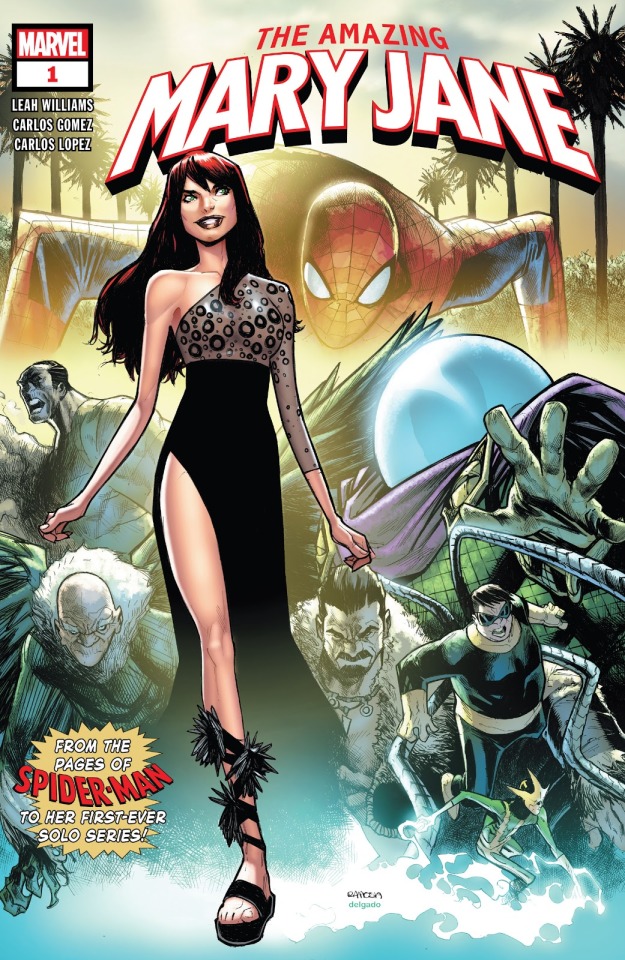
Previous Part
Next Part
Master Post
Now we’ve finally established all necessary contexts we can begin diving into the AMJ series proper. My intent is to break down each issue page by page.
Let’s get started.
We open with Mary Jane shooting a sizzle reel for the film’s investors. Evidently she is playing Mysterio’s super powered love interest.

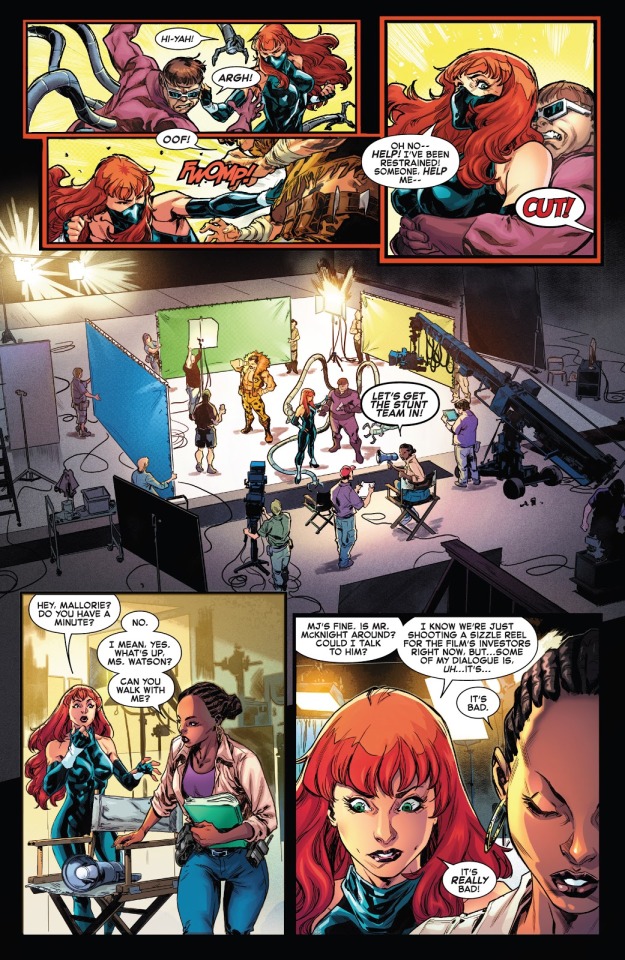
Here we get into our first few problem but I admit it might not actually be a problem.
See, ASM v5 #29 established that MJ has already seen McKnight’s ‘reel’ so why are they filming another sizzle reel?
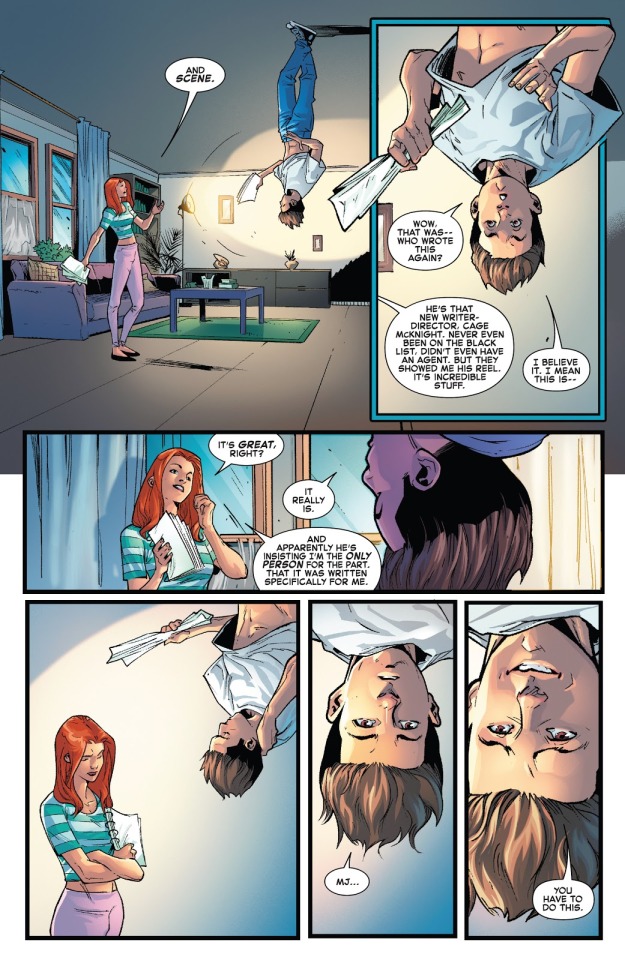
I admit to being in the dark about Hollywood practices so this might be perfectly normal and therefore not a contradiction. Let me know if that is the case.
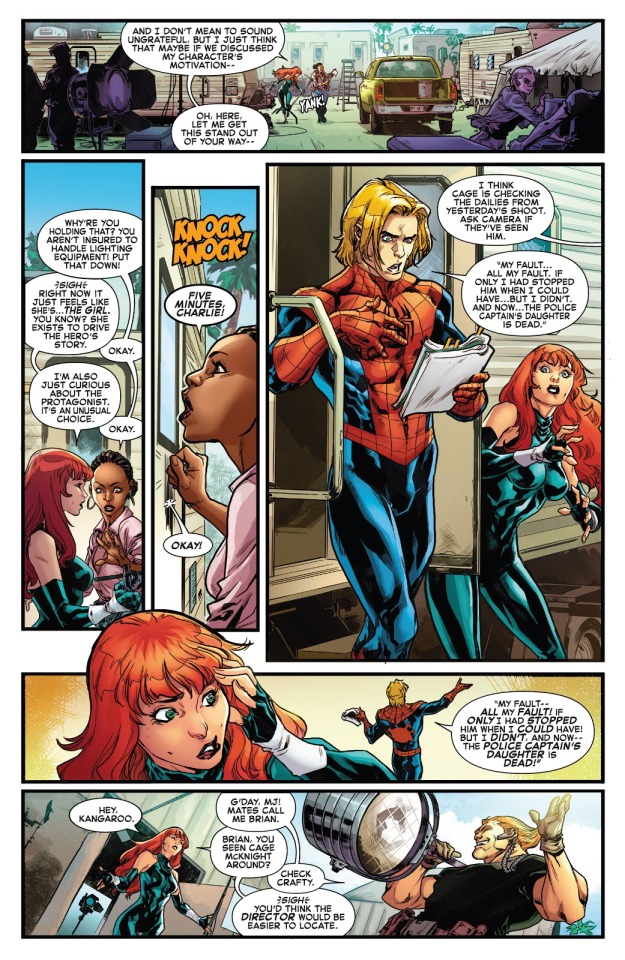
This page introduces yet more problems though they too are rather minor.
The smallest of these is depicting Kangaroo as Australian. Last I checked (and I admit I might be mistaken about this) the Kangaroo was in fact NOT Australian. Or at least this version of the character isn’t as he is the second Kangaroo merely inspired by the original.
That’s a tiny nitpick but I thought I’d mention it. And it’s one that’s easily explained away. He could be emulating an Australian accent for effect or something like that.
The more notable problem is that MJ is deriding the script. This contradicts MJ’s statements in ASM v5 #29/830 where she is praiseworthy of the writing after immediately reading through some of it with Peter.
You could argue that perhaps MJ was commenting upon the script in general and not specifically her own part. As in her starring in this movie would be great for her career because the movie in general was looking to be great. Or alternatively the script for the sizzle reel was bad.
But consider that the script is directly based upon Webspinners #1-3, which (again I might be mistaken about this too) I do not recall ever featuring Mysterio’s would be lover as anything like a super heroine.
Again, this is reconcilable. Rewrites happen. Embellishments on the truth happen.
But to me the reality seems be that either Williams was unaware of the movie being based upon Webspinners (which is entirely possible) or that she wanted to go in another direction for the story.
Either way, it’s a weakness of the comic book but not a deal breaker of a problem.
This page also represents one of the problems from an analytical standpoint with this series.
There is a certain amount of ambiguity through the writing and art in regards to what Mary Jane (and other characters) might be thinking and feeling.
Look at MJ’s baffled face when looking at the Spider-Man actor on the above page.
My initial impression was that she could be simply weirded out by seeing an overdramatised version of her lover. In particular when he’s going over a tragic event in his and her own life (Gwen’s death).
It could just be bafflement over why that’d even be in the movie. After all what has Gwen’s death got to do with the life of Mysterio. I guess Spidey’s implication in Gwen’s death was public knowledge but it still has nothing to do with Beck.
Alternatively that facial expression might (and I emphasis this as speculation) represent MJ’s confusion and concern about that being included in a film. That is to say that’s something of a personal cut for Spider-Man and Mary Jane’s life. She could be wondering if someone knows the truth about Peter’s identity?
If the latter is the case it might go some way into alleviating and explaining other problems I have.
But I just don’t know, because the comic is not making it clear-cut. To my eyes that look says ‘this is so surreal’ and doesn’t say ‘This is concerning. Could Peter and I be in danger?’
However if that was the intention it might’ve been intended to then organically transition into the acknowledgment that there are literal super villains on set and the consequent page in which MJ comments that Cage McKnight fleeing is suspicious.
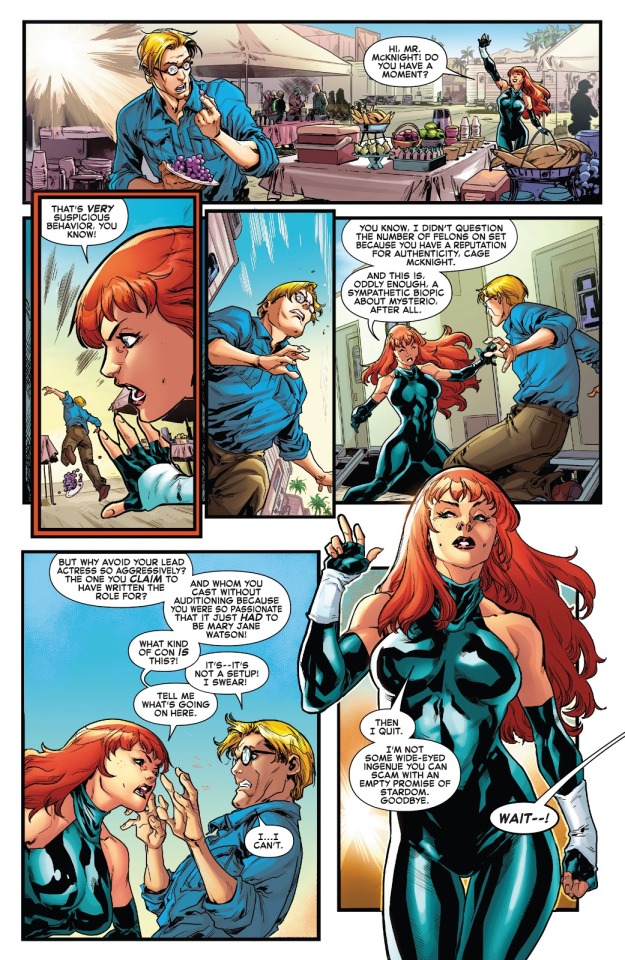
Here is where we’re starting to get into the bigger problems, but let’s start with a smaller one.
The scene implies that McKnight is a an actual person and a respected filmmaker. This is again contradictory to ASM v5 #29. There MJ referred to McKnight as very new, as someone who lacked an agent until very recently. The implication by Spencer was clearly that McKnight was a false identity that Beck invented. Williams/the editors is clearly ignoring that. That’s not a good sign, although it’s not irreconcilable. It’s entirely possible that MJ’s dialogue in ASm v5 #29 in-story was actually true.
Mary Jane comments that there are felons on set. She didn’t question this because Cage McKnight has a reputation for authenticity.
This line can be interpreted one of two ways.
a) MJ didn’t question actual criminals on set and didn’t do anything about it.
Or
b) She phrased herself badly and what she meant was former felons, or that she presumed they were reformed/reforming felons.
The latter is a-okay, the former though....wtf?
MJ’s lived with a man who she knows spent most of his life torturing himself over allowing ONE criminal to walk free. She’s on set with a whole crew of criminals, including super villains and she’s shrugging it off? She’s not even questioning it?
‘Authenticity’ be damned, it’s illegal and potentially dangerous to knowingly harbour criminals, let alone super powered ones.*
But again, I’m willing to give the benefit of the doubt on that line. Between Cage’s reputation and the fact that so many criminals are working out in the open its not unreasonable for MJ to take it on faith that everything was on the up and up (even with the presence of super villains). After all the only confirmed super villain on set is the D (or Z) lister the Kangaroo who has at times been one of the good guys.
Mary Jane though is smart, socially savvy, can get a decent read of people and did study psychology for a time (she never completed the course but still). So she can tell something weird is up and it’s clear the intention is that she’s been growing suspicious for a while now.
In this essay series I don’t plan on praising the issues as that’s not the point. Besides I do that in other posts anyway. Nevertheless it’s worth pointing out that Williams really hits the mark on MJ’s personality here.
Her statements about Cage ‘claiming’ to have written this role for her (where she conveniently plays the love interest to a super person) and simply handing it to her imply MJ is detecting a trap. This touches on what I said above about her facial expression. About how it’s possibly intended to float the idea that she’s concerned that someone’s figured out Peter’s secret.
However, she could just as easily be thinking this is a trap specifically for her. After all, she’s been targeted by stalkers before (like Jonathan Caesar). That interpretation is arguably supported by MJ’s line about being scammed with an empty promise of stardom. Even if she doesn’t think this is some kind of super villain grand scheme of any kind it’d likely ring alarm bells for any young and (by stereotypical standards) attractive person in Hollywood; at least it would nowadays.
As we move onto the next page Cage reveals himself as in fact Mysterio and confesses he engineered this con in order to tell his life story.
He proceeds to inform MJ what is and isn’t real about the film and explain where the real Cage McKnight is. In doing so he admits that the film is happening through fraud, identity theft (sorry I don’t know the correct legal terminology) and the hiring of former felons and active criminals.
More specifically he produces (what he claims to be) a live video feed of the real Cage McKnight’s location on the Falkland Islands where he will be spending around a year on a film project that doesn’t actually exist. He also claims that this project is his last chance to do something good with the ‘time he has left’ (implying he is dying) and that he wanted to give the felons and criminals a similar chance to make something good and meaningful.
After being honest with her, MJ admits this situation is insane, but then agrees to go along with it.
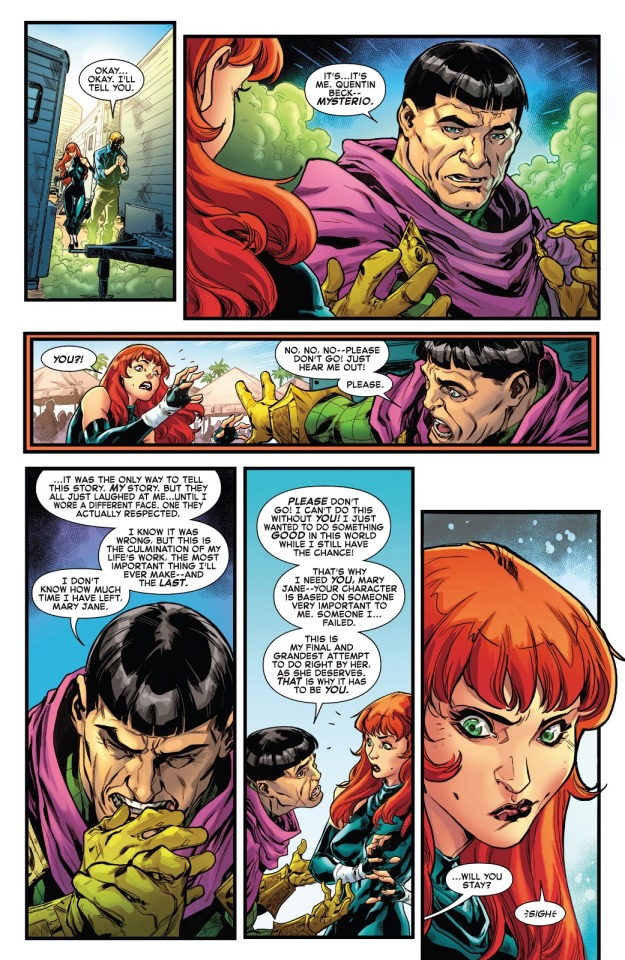
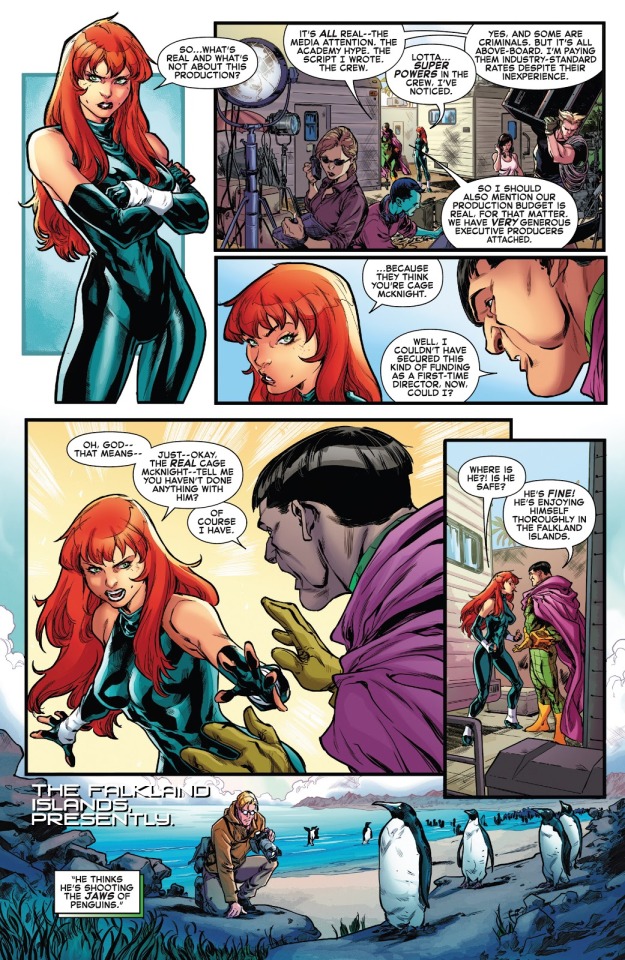
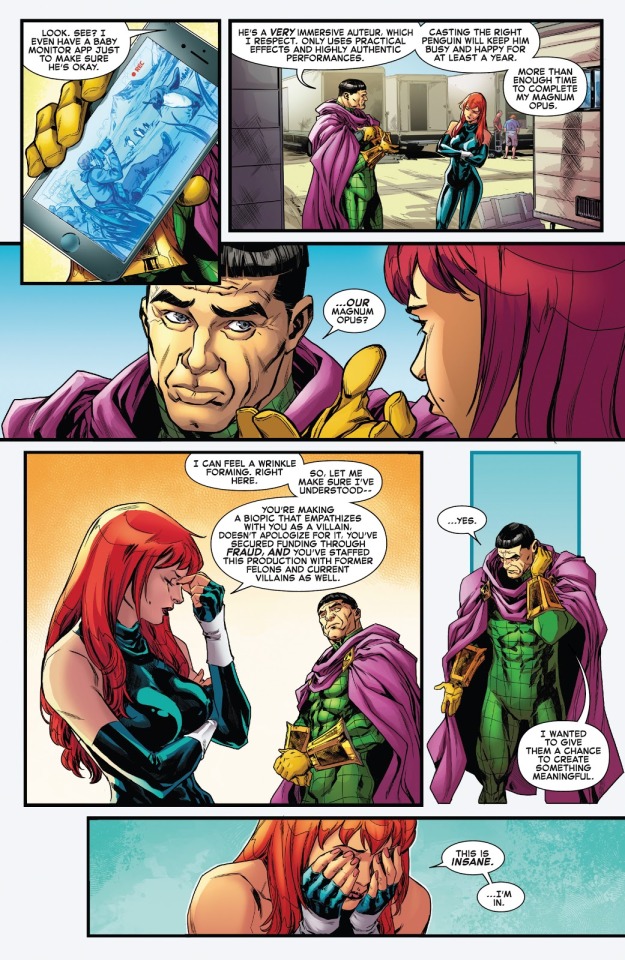
First of all let me get this out of the way. Mysterio has actual active criminals on set but he also wants media attention. Isn’t that counter productive? The media are going to report that (some of the crew are obvious more than human, with green skin no less) and it’s going to cause both unwanted attention from the authorities and problems in general.
With that said let’s talk about the bigger issues with these pages.
Part of the problem in analysing them is that it we have to consider things from the POVs of MJ, Mysterio and our own (which is semi-omniscient).
We know Mysterio:
Is in the employ of the demonic Kindred who’s working a vendetta against Spider-Man.
Faked his own death again back in ASM v5 #24-25
Is doing this movie to make the most out of his time before he is dragged back to Hell
Is aware of Peter’s identity and that it’s highly likely he demanded MJ’s inclusion in the movie (whether of his own volition or on Kindred’s orders) specifically because of her connection to Spider-Man
Essentially we know Mysterio’s reasons for making the movie (including his limited time) are true…but they also omit certain important facts.
In other words…he’s acting.
He has legally (and more often illegally) worked as an actor. He was able to fool executives who literally work in the film industry where actors are basically a prerequisite. He is a massively skilled manipulator.
And here, the context the audience are aware of, conveys that he’s using the truth to get what he wants but is nevertheless withholding the real truth. Maybe this will be addressed later but at the moment it is beyond unlikely that Mysterio truly felt MJ was simply the only person to play his love interest. She is obviously there because of her connection to Peter.
Me personally though, I am not exactly certain Williams wrote this moment with the idea that Beck was being actively deceptive. My personal impression is that she was writing Beck as sincere and simply vulnerable because he knows he'll be returned to Hell soon. This vulnerability would be the reason for his opting for honesty. Now I don’t have any evidence to back that up I will admit, we will have to see as the series progresses.
But the most important thing about this scene isn’t our POV nor Beck’s, but MJ’s.
She is the lead character the person the story revolves around, her actions, decisions and agency is what is paramount in the context of this series.
From that perspective these three pages alone put us several layers into serious mischaracterization.
MJ wouldn’t help Beck because he’s hurt her loved ones
Even if he hadn’t she wouldn’t trust him because of the other horrible things he has done that she knows about
Even if she didn’t know about those things she knows his M.O. and abilities and thus wouldn’t trust him
Even if she sensed sincerity she’d not help him because he’s committed and still committing several serious crimes and unethical actions in this very story
Even if she believed those crimes weren’t so bad and that he was sincere she’d be smart enough to consider the possibility that he’s tricking her and double check what he’s told her
If she presumed (not that there is any evidence of this in the comic) that Beck was out legally and she ignored him obviously engaging in identity theft, she’d still double check those fact and learn that he has in fact escaped.
No matter how you slice this Mysterio is very much in the wrong here and so is Mary Jane. She even admits it’s insane and then agrees to go along with it.
Not only is she out of character to nuclear levels but even if this was a completely new villain MJ had never heard of before the mere fact that he’s clearly committed serious crimes to get to this point and is going to continue to do so (chiefly by impersonating McKnight) should be enough to make her her to bow out.
There is soooooooooo much more I could write about this because it cuts to the heart of the problematic premise as presented by the issue. However I will dive more deeply into that in numerous future instalments once we are done with issue #1.
Moving onto the next few pages, MJ predicates her agreement on the condition that her role be rewritten to improve her character.
This is a fact that she explains will actually improve the film over all. Their discussion occurs as Mysterio gives her a tour of the set and they chat about rewriting her character.**
During the course of this tour Mysterio unveils some of his film techniques and (at least seemingly) confirms what is and is not real about the production. Among the techniques he is using are his incredible holographic technology and his robot duplicates of the X-Men from ASM Annual #1.
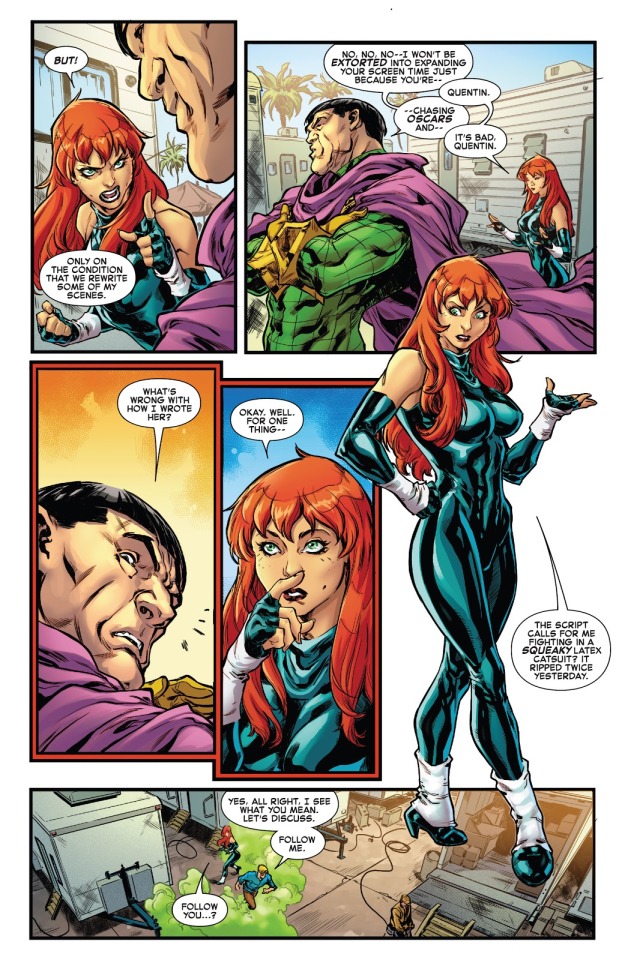
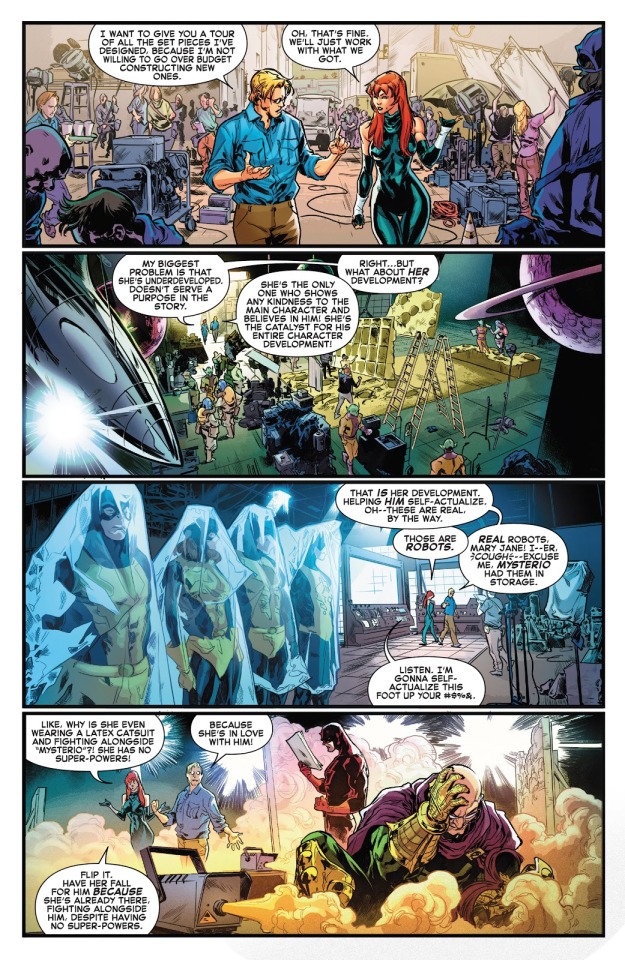
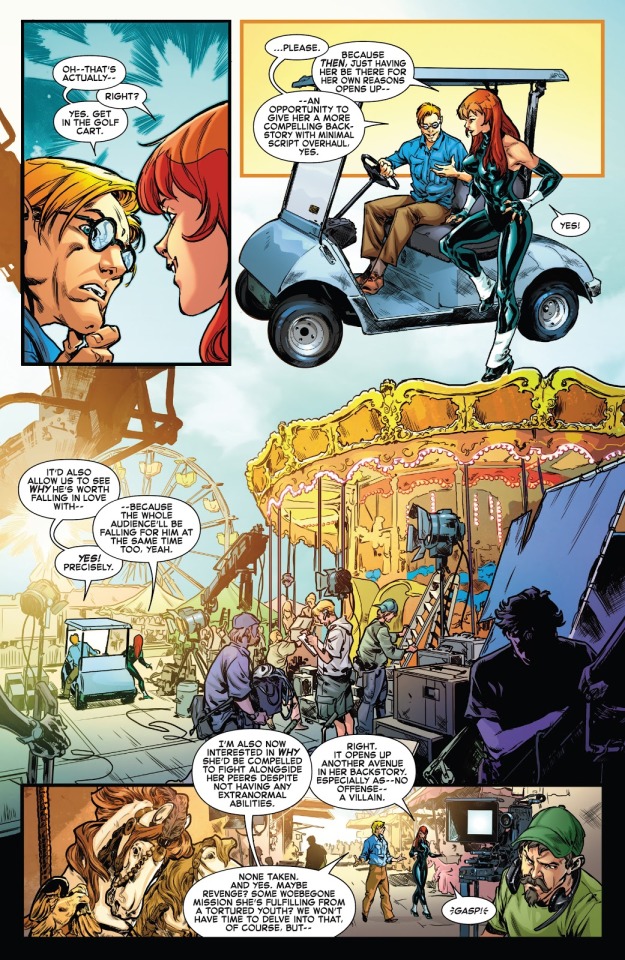
This tour also includes a direct reference to Mysterio’s suicide from ‘Guardian Devil’, implying the artist and editor at least are aware of the events of that story. I’d like to imagine Williams is too. Regardless it’s problematic for the comic to acknowledge those events but treat Mysterio sympathetically in light of what he did in that story. And needless to say it’s problematic to write MJ as so chill around Beck in this scene/comic given how she knows about those events because she was in the story!
Anyway, MJ gets excited by the prospect of a spin off sequel. That in turn prompts one of the crewmen to imply she got her job through ‘womanly wiles’.
This enrages ‘Cage’ who assaults the man, an event witnessed and recorded by the surrounding crew. As she witnesses these events her self MJ has a curious facial expression.
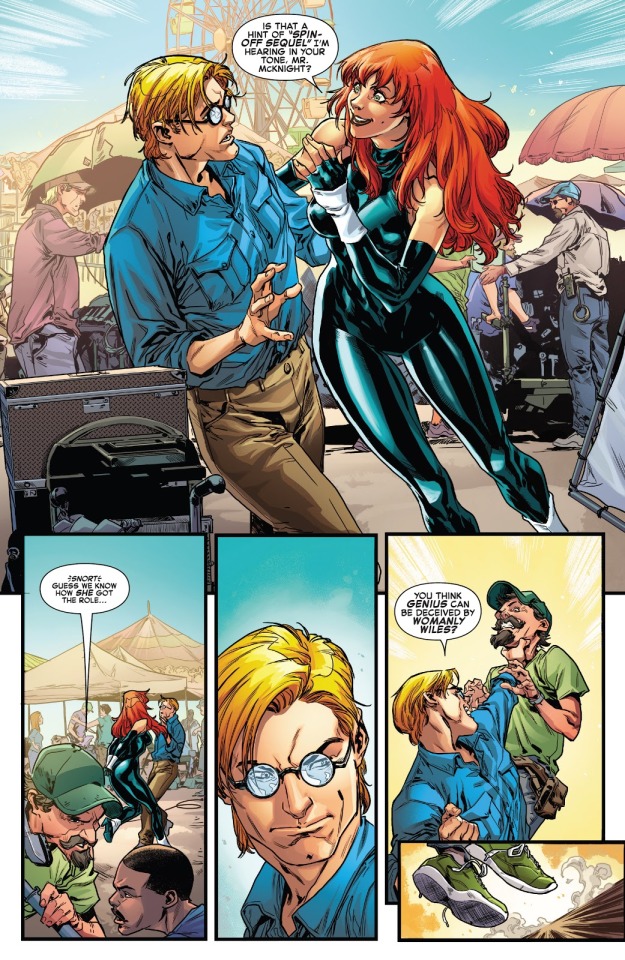

Much like her expression seeing the actor playing Spider-Man, MJ’s face here is difficult to interpret.
It could mean any number of things.
Could she be viewing Mysterio as someone she’ll have to play carefully?
Is she thinking she’ll have to do her best to ensure he doesn’t get out of hand, whether it’s for her own protection or others’?
I do not know. It’s kind of vague. Hopefully it’s meaning will become clear in consequent issues, but if I’m supposed to understand clearly what it means in this issue then Williams or Gomez dropped the ball.
Something they didn’t drop the ball on though is Mysterio’s characterization. It’s worth mentioning out of fairness that this emphasis upon Mysterio as a passionate artist is extremely in keeping with his character and Williams handles him expertly on this front.
Beck finishes up his tour with a recreation of a scene from ASM #66-67 and MJ is delighted by the fun she and Mysterio are going to have in making the movie.


Notice that Beck directly references how this set piece is recreating a trap he laid for Spider-Man, how he used psychedelic gas to trick his mind.
In essence this is Mysterio simply stating outright to Mary Jane that he once tried to harm her boyfriend and even drugged him to that effect.
And MJ’s reaction to this is…to giggle with glee.
Really?
She doesn’t even show any hint of apprehension over that? We the readers aren’t even made privy to an internal tensing or recoiling on MJ’s part to this man just casually mentioning a time he sought to end the life of the man she is in love with?
Seriously, what the fuck. You better believe we’ll be talking more about this too.
Even from Mysterio’s point of view it muddies the waters of his motivations. As we extensively examined in prior instalments, it’s very likely that Beck knows Peter is Spider-Man, and thus by extension probably knows that Mary Jane is his lover. So it’s incredibly stupid on his part to blithely mention to MJ a time he drugged Spider-Man and tried to kill him.
Alternatively let’s say Beck’s hiring of MJ was in Kindred’s orders and he is unaware of the exact connection between her and Spider-Man/Peter. It’s still stupid because he’d still be able to deduce she very probably has something to do with Spider-Man because he knows Kindred wants her out of the way as he wages war on the wall-crawler.
The fact that Beck is written this way indicates Williams is unaware of the Spencer ASM issues which set up AMJ and/or doesn’t care and/or the editors aren’t doing their due diligence . Regardless it’s a major weak spot of the story. It either breaks the larger narrative that exists between the two titles or it renders Beck out of character via his stupidity.
The latter would be true even if Beck simply wanted MJ in his movie just because he liked her as an actress. He’d still be throwing out the fact he drugged and tried to kill someone (a former Avenger no less) in his past.
As the story progresses MJ and Peter have a chat on the phone where she makes a point of alleviating any discomfort he might have over making a sympathetic Mysterio biopic, claiming it is the Breaking Bad of super hero films. She continues by pointing out the career opportunities the role presents.
Peter raises concerns for MJ’s safety, suggesting she might find herself surrounded by villains; ironically unaware that Mary Jane is in that exact situation.
MJ assuages his concerns by reminding him of the time she defeated an actual super villain (the Chameleon, though he goes unnamed) with just a baseball bat.
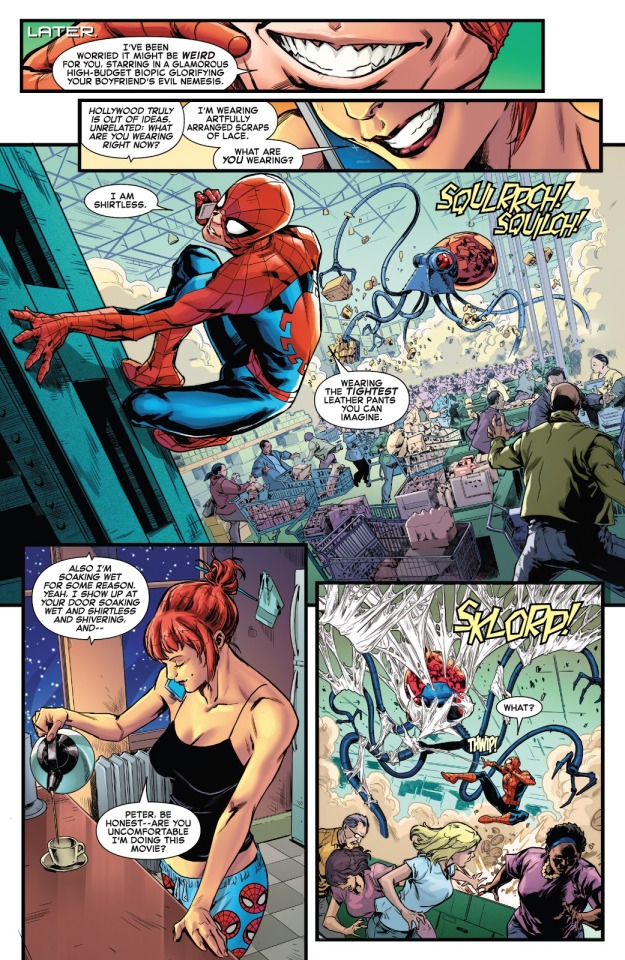
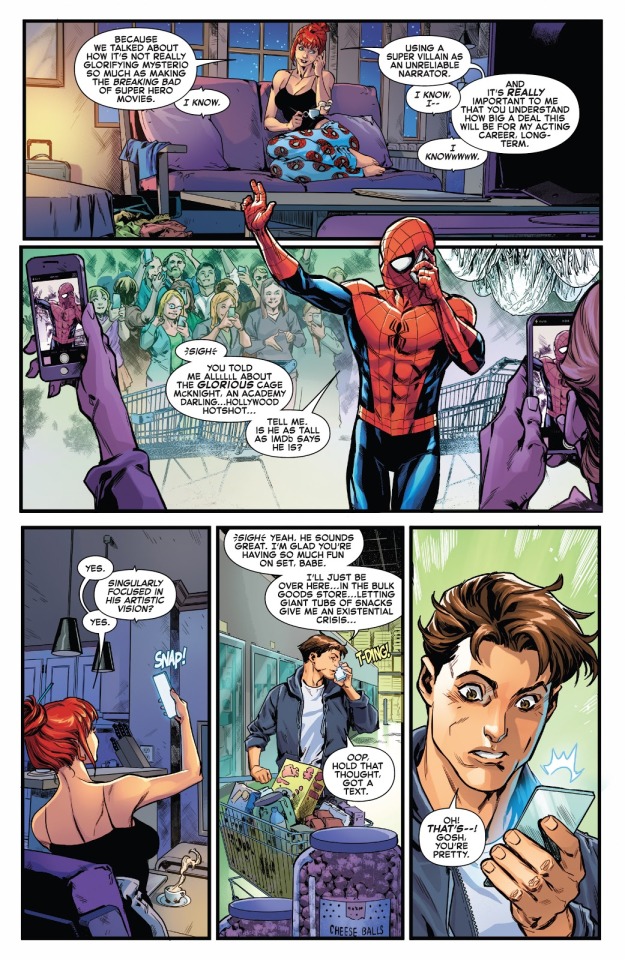

MJ’s statements regarding the movie are arguably contradictory.
Earlier in her conversation with Beck MJ stated that the film empathizes with Mysterio and doesn’t apologise for it.
But then at the end of the story she tells Peter that the film actually isn’t glorifying Mysterio. Rather, it is making the Breaking Bad of super hero movies with an unreliable narrator.
This isn’t necessarily irreconcilable, but it is somewhat poorly communicated on Williams’ part. Breaking Bad’s defining message was that you shouldn’t be like Walter White. That he was in the wrong, even from the very start.
Why would Mysterio ever write a film about himself in that light? It doesn’t make sense and it would contradict MJ’s dialogue about how the movie empathises with Mysterio as a villain and doesn’t apologise for that. Breaking Bad wasn’t empathetic towards Walter White, it showed him very clearly as a monster and its final episode had him admit that fact.
Moreover if the film empathises but never apologises for Beck (and is directed by him personally) then isn’t that tantamount to glorifying him?
Because of this the issue leaves us with three possible interpretations of Mary Jane in this moment.
She is either:
Blinded by the prospect of fame and/or fortune and/or excitement and as such cannot see that the film obviously is glorifying Beck. To an extent we’ll talk more about this in a future instalment. Suffice it to say that’s very out of character
She is outright stupid, which is also out of character
She is deliberately lying to Peter about the artistic nature of the film project. There is a strong case (that we will get to) for MJ lying to Peter about Beck being out of character for her. However, were this a regular film production it might not be an OOC move for her. She wants to make the movie and alleviate her boyfriend’s feelings for the moment. Fibbing to keep their long distance relationship healthy and happy and hopefully being more straight with him when it’s over is not an unreasonable thing to do.
Options 1)-2) don’t exactly paint Mary Jane in a positive light, nor does option 3) necessarily.
MJ just isn’t this stupid, isn’t this capable of being star struck (she’s seen too much serious shit in her time for that) and lying to the love of her life about something like this is questionable. On the latter point it can be argued that there’d be no advantage of her lying to Peter about the project because he’s obviously going to find out when the movie is released.
Personally I suspect Williams never intended to imply any of the above interpretations.
I think she or the editors just didn’t catch that the dialogue at the end of the issue contradicts the dialogue from earlier. Which would be bad writing/editing but not demonstrative of Williams not fundamentally understanding the character. On occasion Stan Lee himself mischaracterized Spider-Man by accident.
Nevertheless a moment that reflects badly upon MJ.
The last moment from this scene involves a ’20 second dance party’ between MJ and Peter.
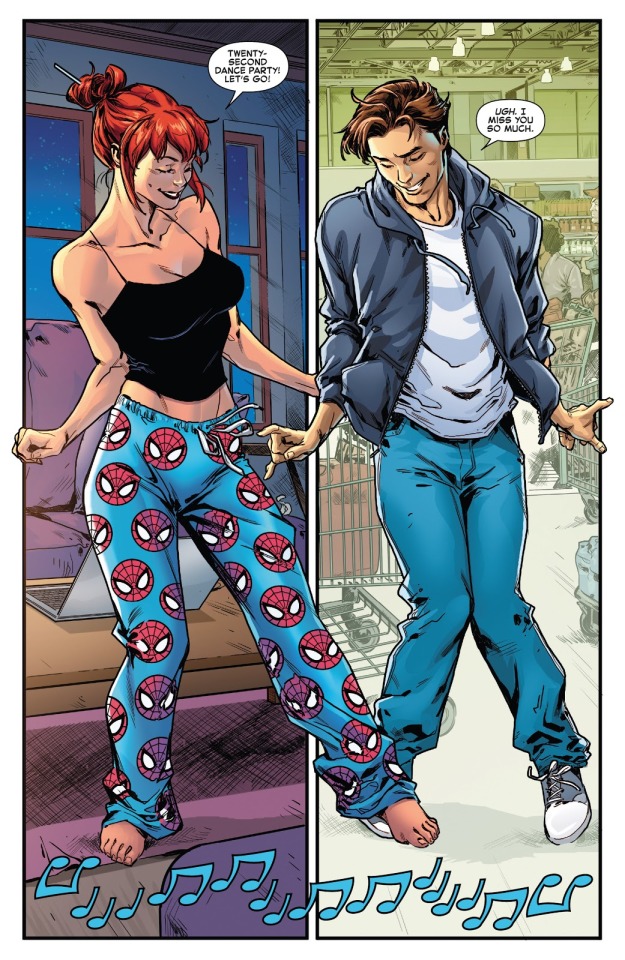
Its only relevance to this analysis is to exemplify some ways in which Williams nails Mary Jane’s character.
She’s flirtatious, she’s vibrant, she loves to dance, she loves to party, she can get the overly serious and often angst ridden Peter to emerge from his shell. Combined with MJ’s savvy earlier in the story, her tenaciousness and references to old continuity I can absolutely understand why Williams seemed like a good pick for the project.
But it’s moments like these that frustrate me about this comic (and I suspect the series going forward). It’s not that Williams fundamentally misunderstands Mary Jane but she drops the ball in a few places. Unfortunately those include drops that are so huge that they break the entire story. At least that will be the case if she doesn’t fill in the holes in her narrative.
The end result though is an extremely mixed bag wherein you have logic holes and mischaracterization so bad it debatably counts as (unintentional) character assassination but at the same time some of the absolute best Mary Jane or Mysterio moments ever! The 20-second dance party is going to be fondly remembered by every Mary Jane fan and MJ/Peter shipper forevermore, and rightly so.
But equally, unless properly justified in the future, MJ knowingly teaming up with Mysterio deserves to go down as one of the all time worst out of character moments for her ever.
The final relevant thing from the issue to talk about is the last page. It entails the Vulture’s gang of villains (the Savage Six) reading an article about the Mysterio biopic and deciding to head for L.A.
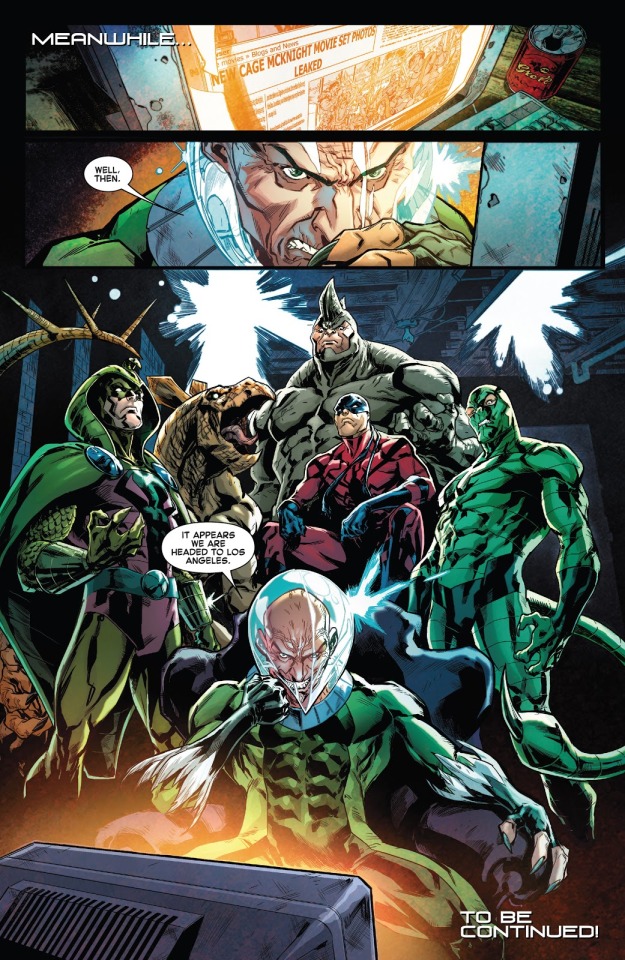
This is only really relevant for two reasons.
The first is the set up it supplies for future issues.
The second is that the article specifically talks about leaked set photos.
This further plays into the confusing nature of Mysterio’s scheme. He wants the media interest to act as a form of publicity (arguably this leak is an example of that) but he also has current villains on his staff. Wouldn’t the press be likely to find out about that and thereby jeopardize the project?
Reputation for authenticity or not, that’s extremely illegal.
With aaaaaaaall that said it’s time to move onto dissecting the status quo set up by this issue.
It’s all subject to change of course. Williams might address each and every problem eloquently at some point. But taking it at face value I am going to dedicate one (or more…) instalment(s) of this essay series to exploring the problems presented by this premise.
*We will talk much more extensively about this in a future instalment I promise you.
**By the way I don’t quite understand what MJ is asking her character to be rewritten into. She asks why she’s fighting without super powers but then says she should already be doing that in the story and that this is how she falls in love with the hero?????????????????????? Maybe I’m being dense but that just wasn’t clearly communicated to the readers).
Previous Part
Next Part
Master Post
#Amazing Mary Jane#Leah Williams#mjwatsonedit#mary jane watson#Mary Jane Watson Parker#MJ Watson#Spider-Man#Carlos Gomez#Mysterio#quentin beck#Peter Parker#Savage Six#Adrian Toomes#X-Men#vulture#The Vulture
11 notes
·
View notes